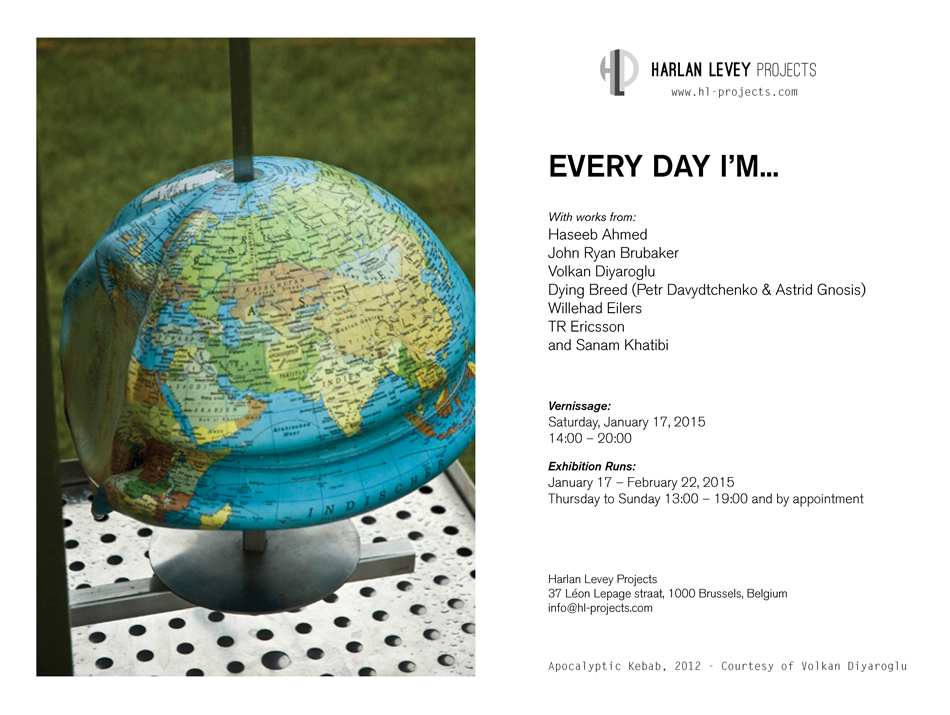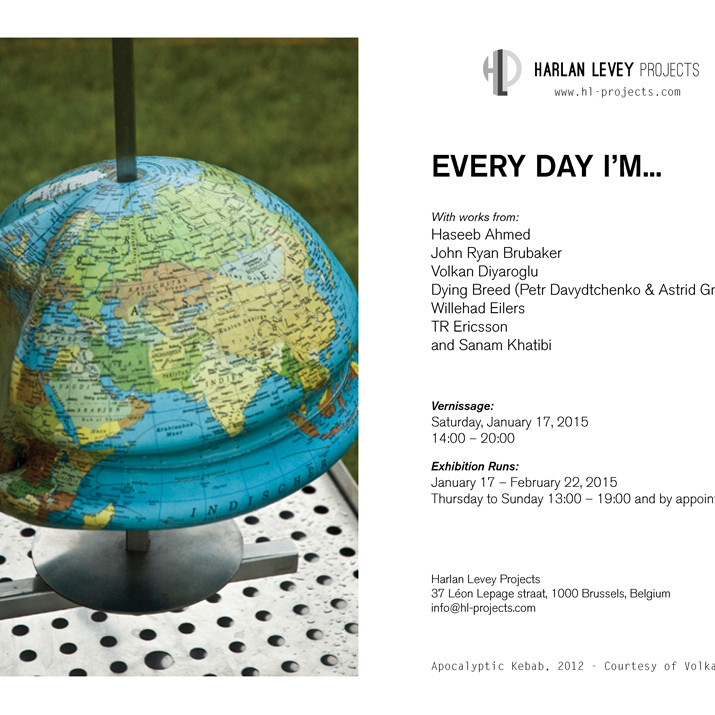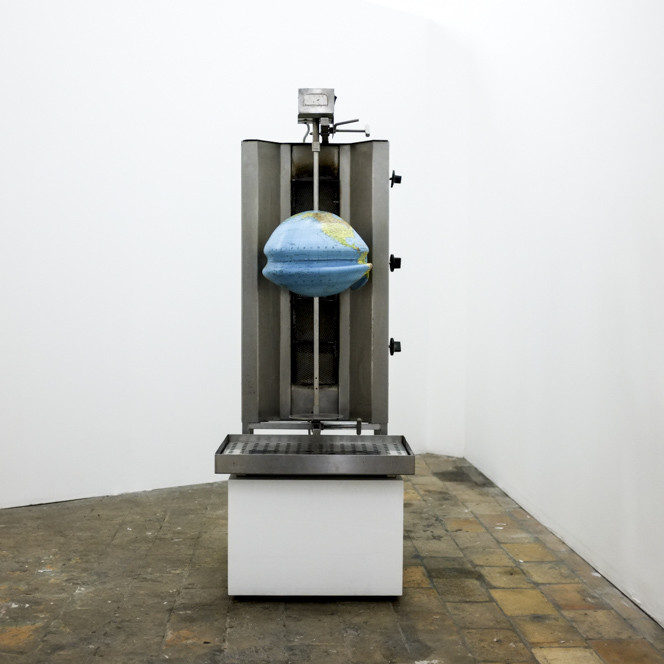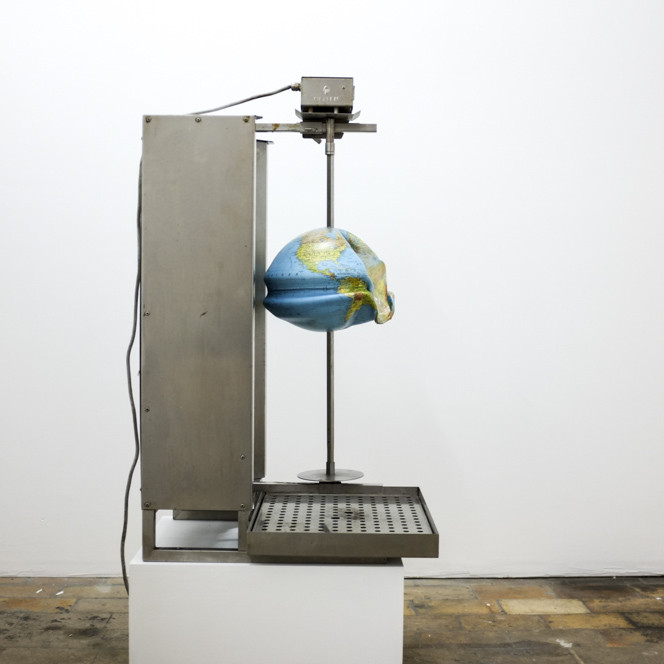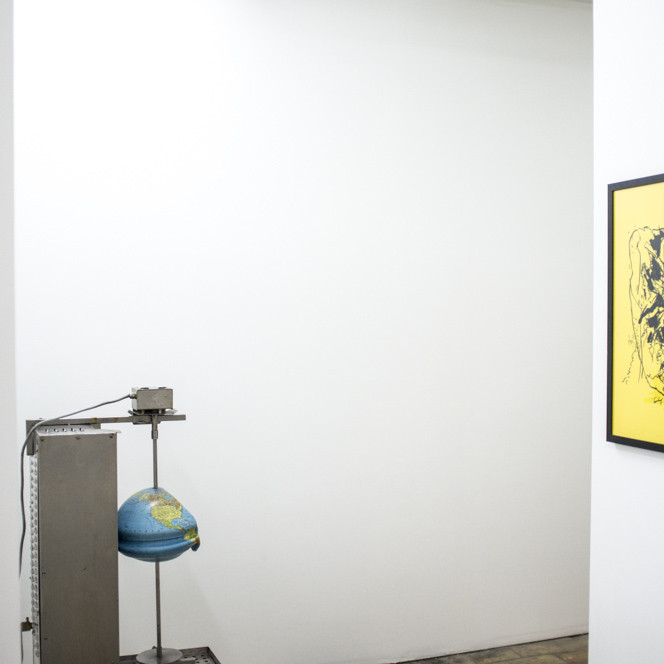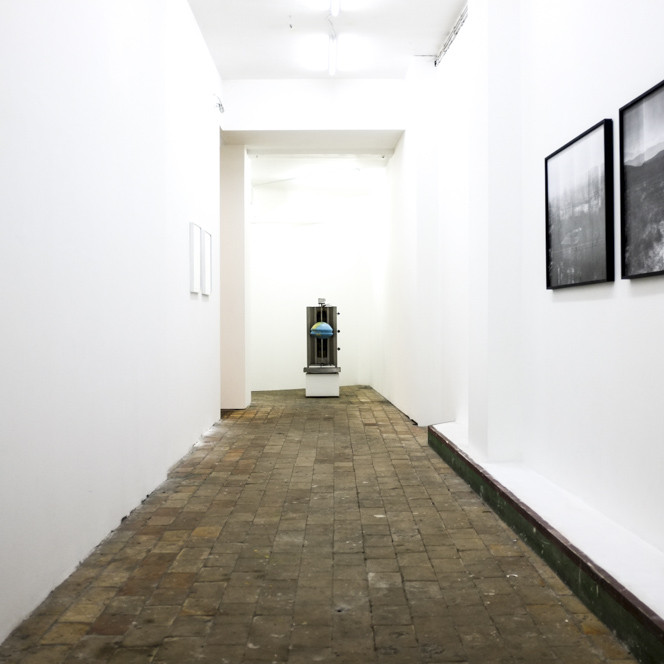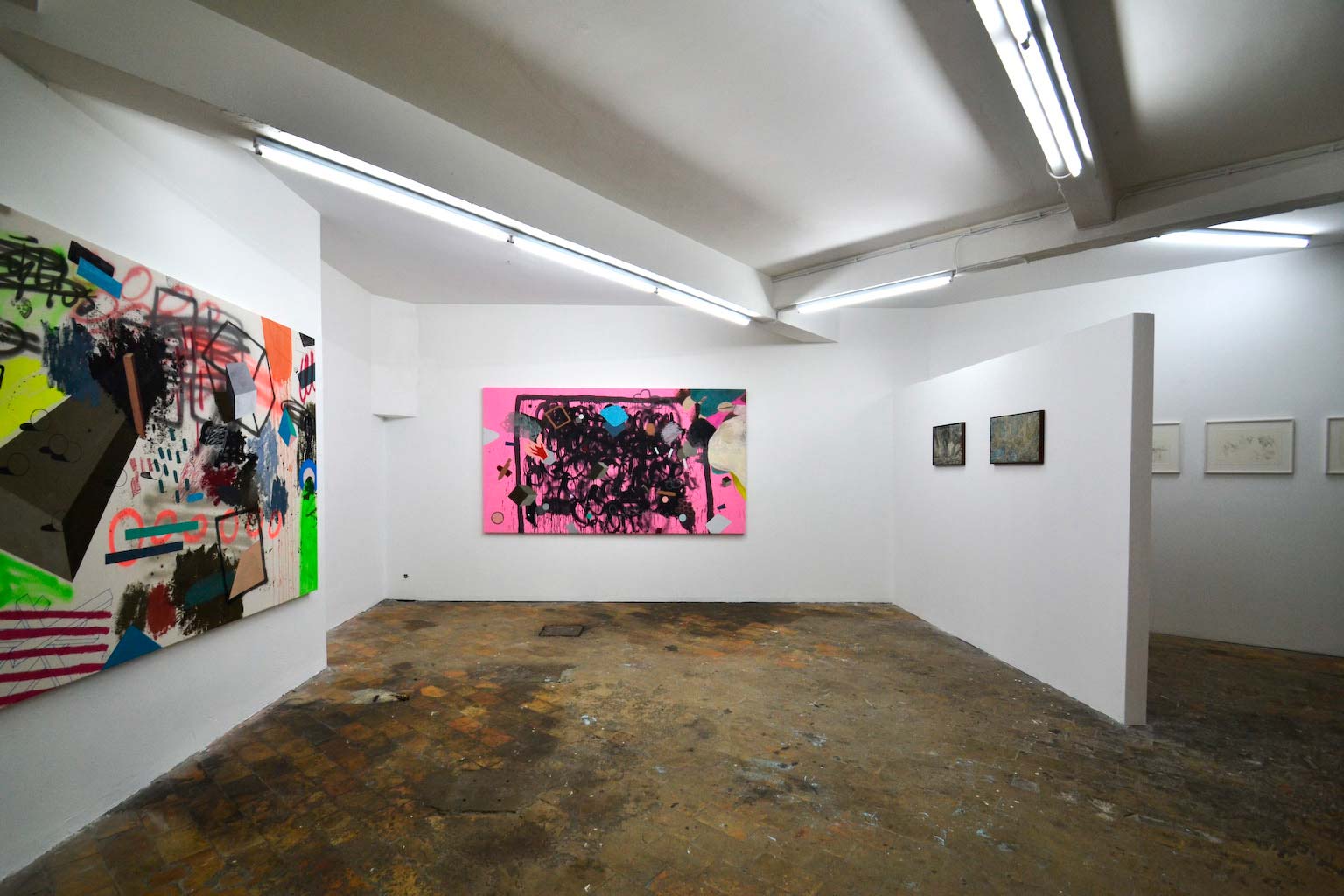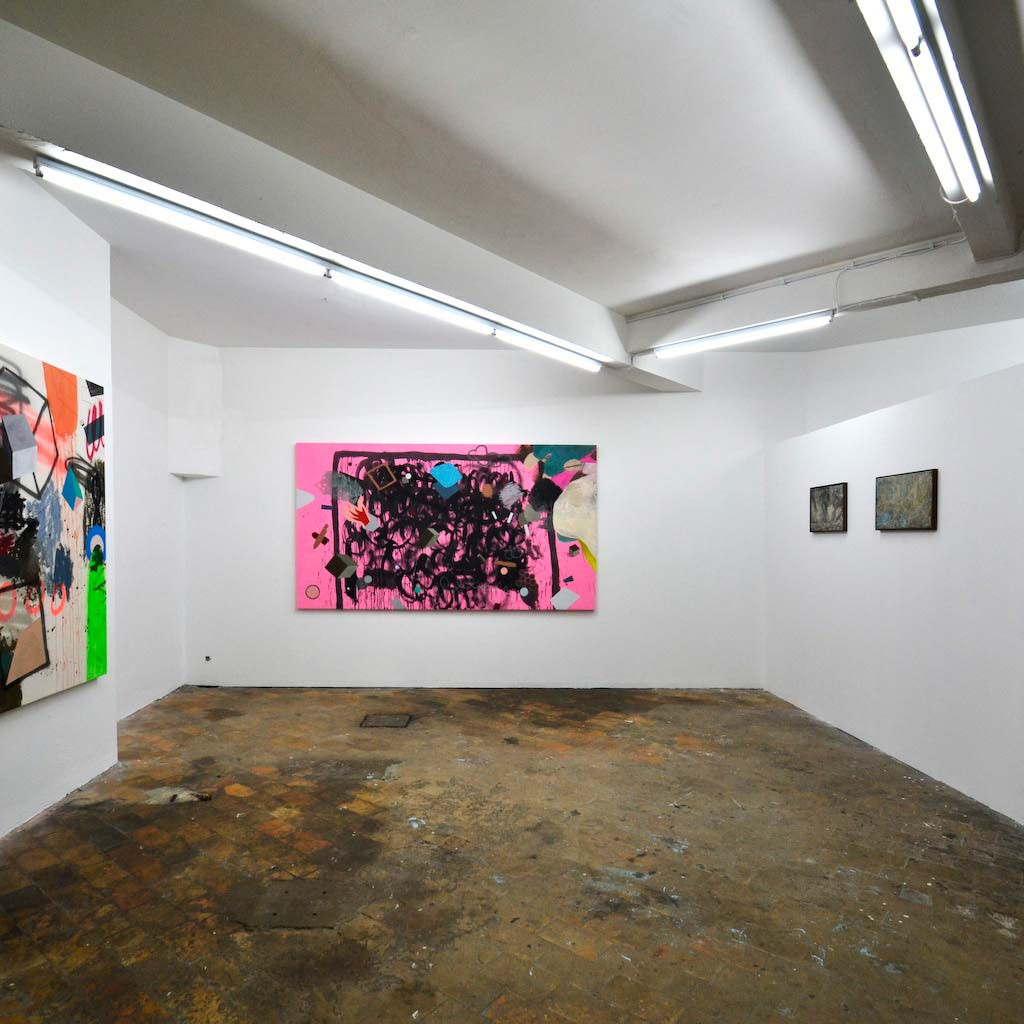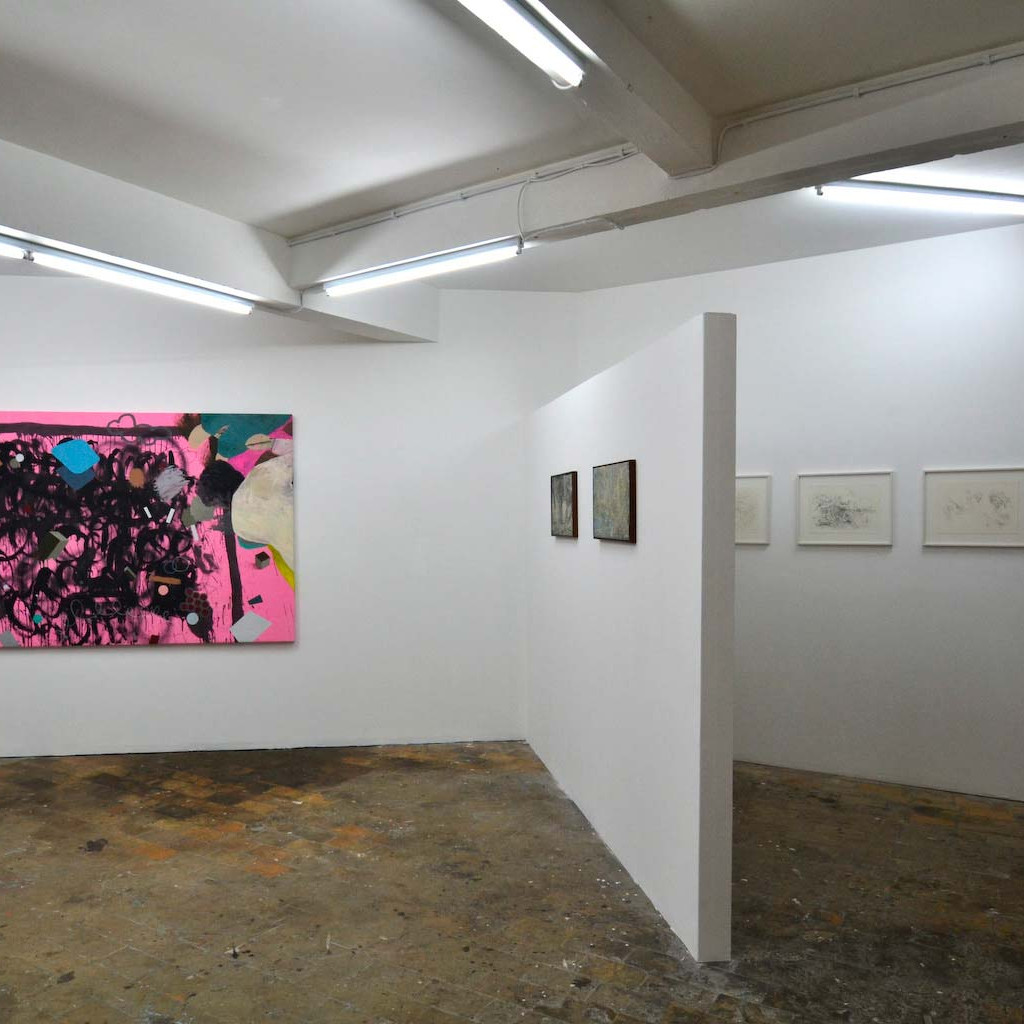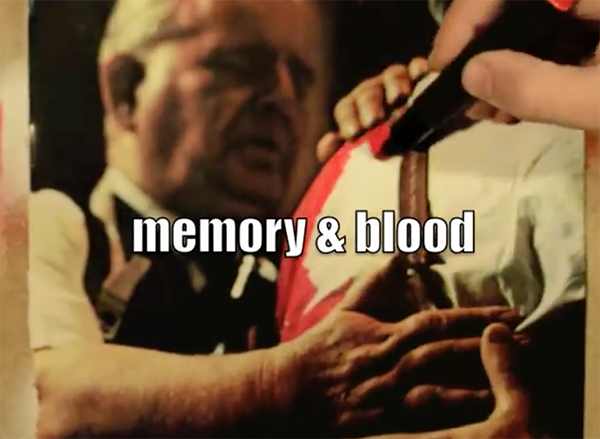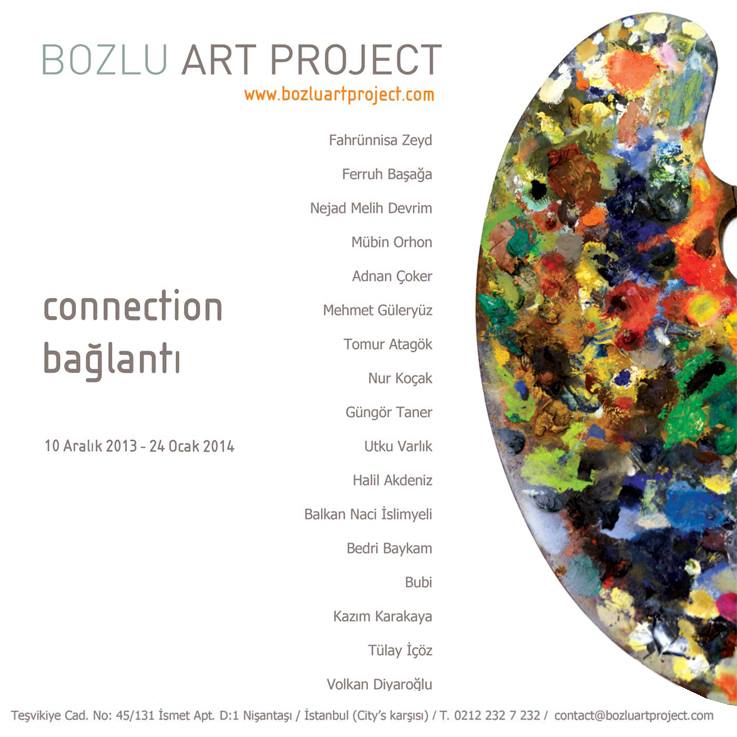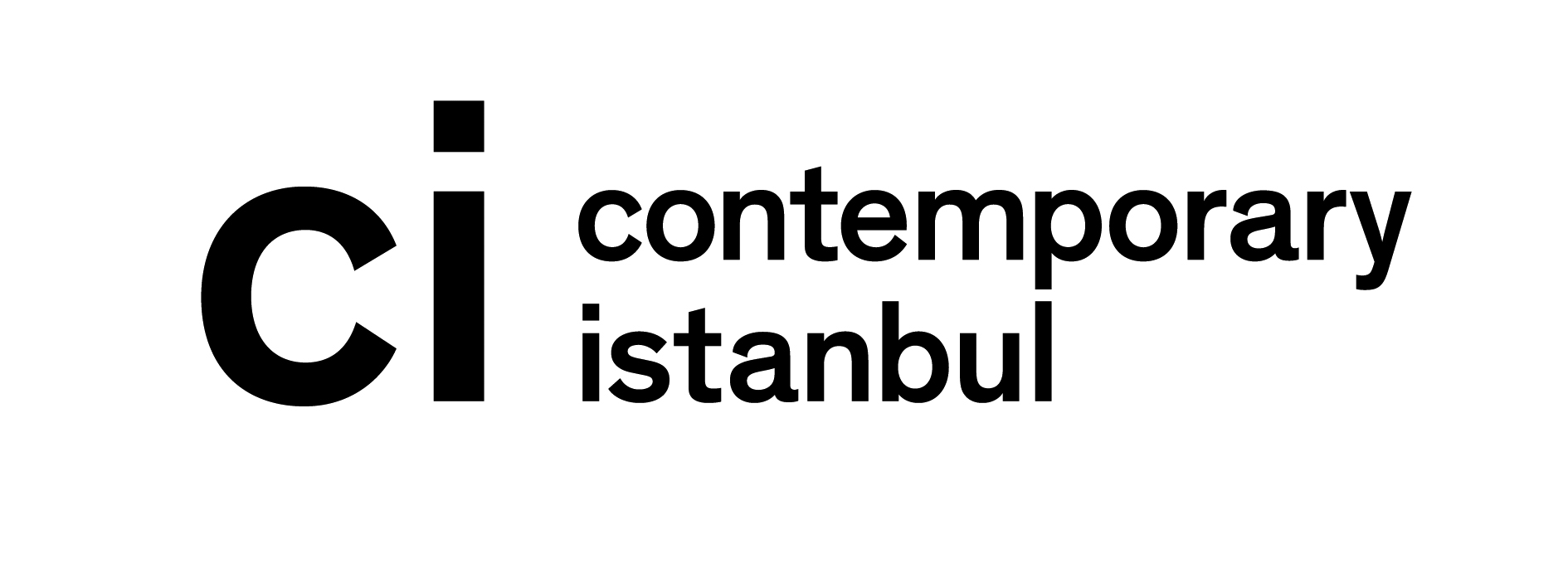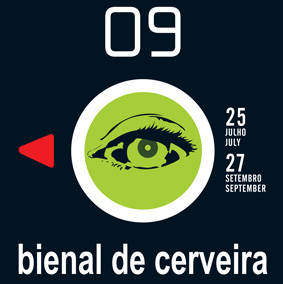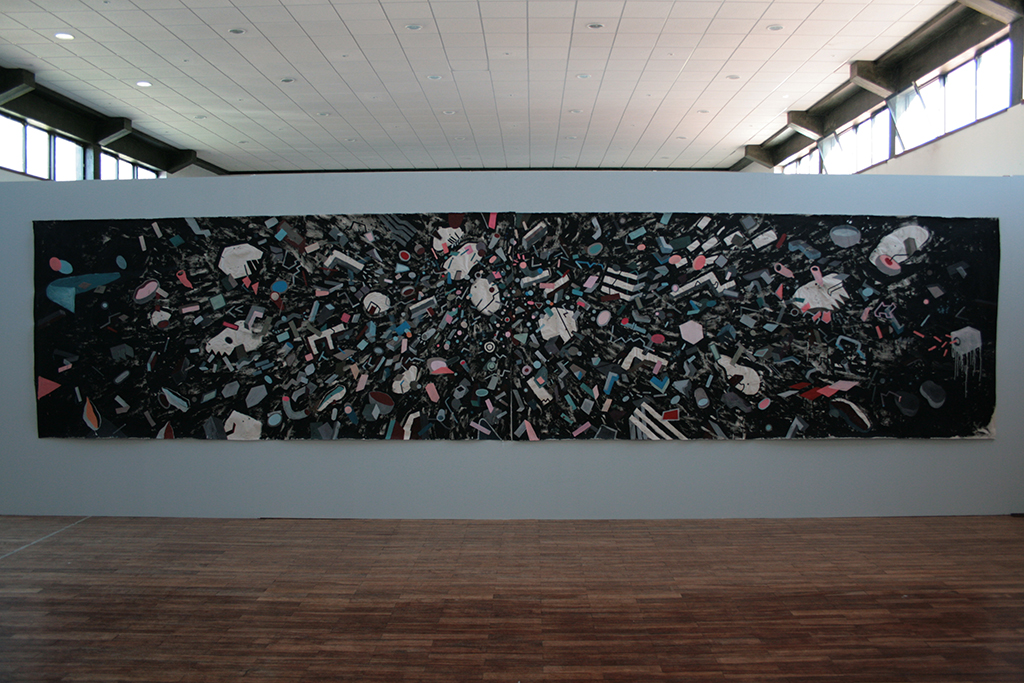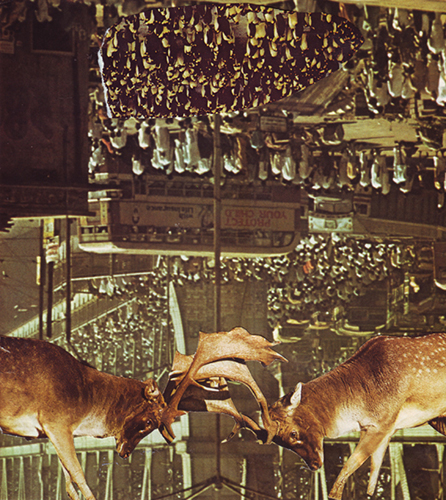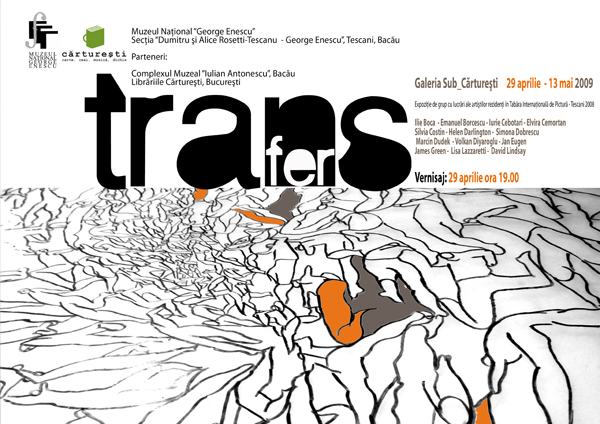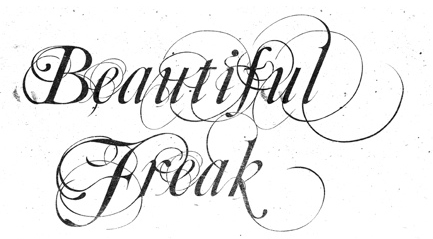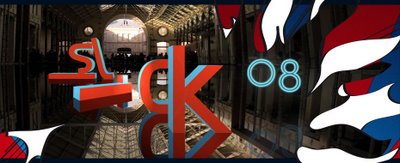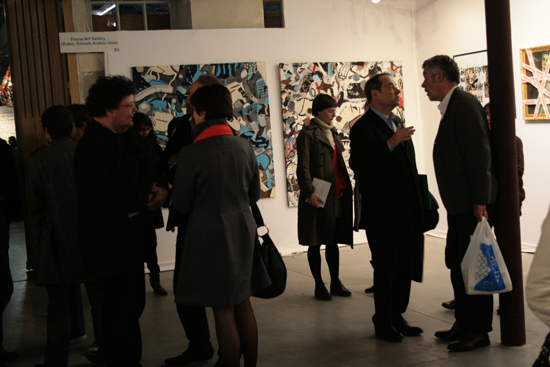Low Cost Diplomatic Bag: Boarding / MADRID
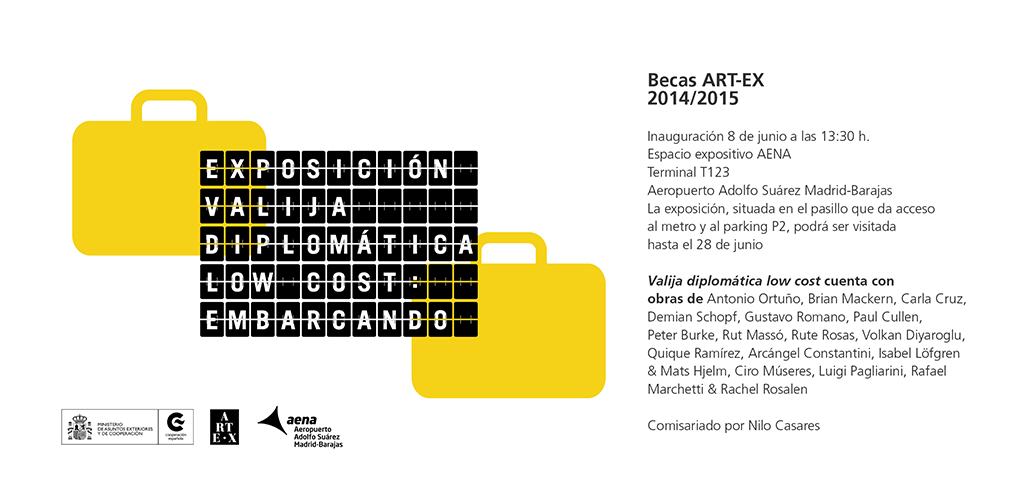
Low Cost Diplomatic Bag: Boarding
This is the starting point of the exhibition “Diplomatic bag low cost” that will visit different cities around the world thanks to Aecid’s ART-EX program.
“Low cost Diplomatic” is a collective exhibition of contemporary art. It manipulates the space inside a suitcase that can fit in the cabin of a budget airline, the most widely used means of transport.
The inside of the case can be seen by launching it from each of the QR codes that you will find next to it or following the itinerary of the exhibitions. The first stop will be Spain’s Cultural Centre in Santiago de Chile, where it will be opened on 28 July 2015. All passengers in transit are invited to attend this and the rest of the exhibitions. Information on them can be accessed at http://art-ex.es/portfolio/
Low Cost Diplomatic Bag includes the following works:Read more
(P)ANAMORPHOSE(S) / ART BRUSSELS 2015 Artists And Curators Run Spaces
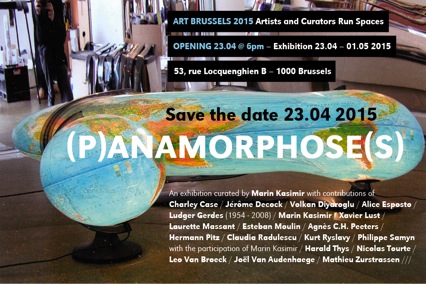
An exhibition curated by Marin Kasimir.
Opening: 23.04.2015 / 6 pm.
Exhibition: 23.04 - 01.05.2015
53,Rue Locquenghien
B-1000 Bruxelles
Artists: Charley Case +++ Jérôme Decock +++ Volkan Diyaroglu +++ Alice Esposto +++ Ludger Gerdes (1954 - 2008) +++ Marin Kasimir
+++ Xavier Lust +++ Laurette Massant +++ Esteban Moulin +++ Agnès C.H. Peeters +++ Herman Pitz +++ Claudia Radulescu +++
Sylvestre Gobart +++ Kurt Ryslavy +++ Philippe Samyn (with the participation of MK) +++ Nicolas Tourte +++ Joël Van Audenhaege +++Read more
A NEW SELECTION FROM THE ELGIZ COLLECTION / 17 June - 1 November 2014 / ELGIZ MUSEUM / ISTANBUL / TURKEY
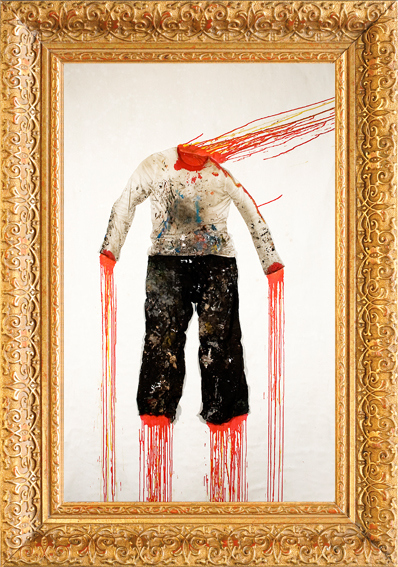
CLIMATE CHANGE / BOZLU ART PROJECT / ISTANBUL / 2014
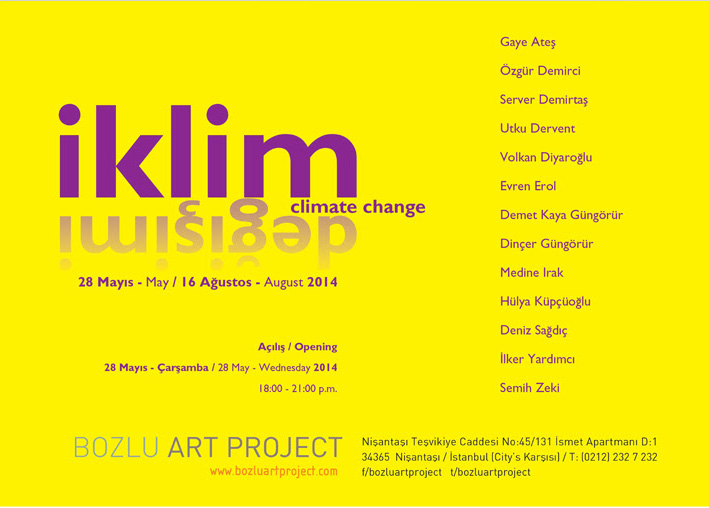
CLIMATE CHANGE
nişantaşı - istanbul
“CLIMATE CHANGE”EXHIBITION AT BOZLU ART PROJECT NISANTASI
I WISH I HAD A RIVER / HARLAN LEVEY PROJECTS / BRUSSELS
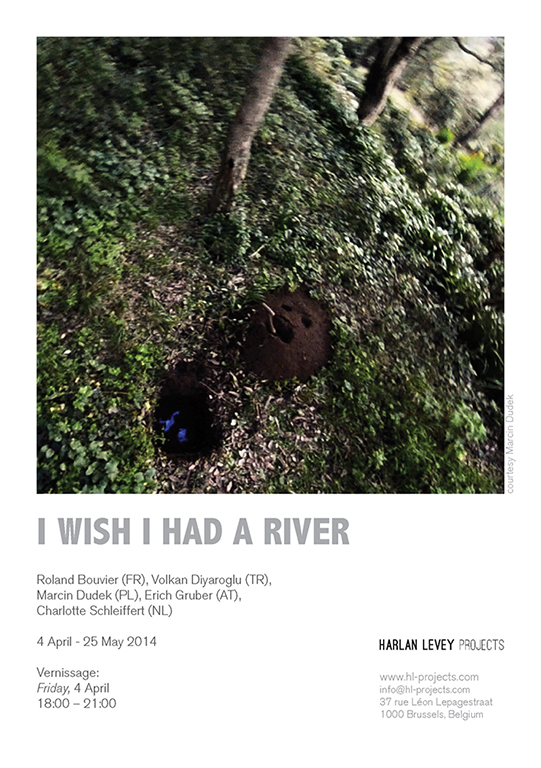
HARLAN LEVEY PROJECTS / BRUSSELS
Opening: 4th April – 25th May 2014
An exhibition featuring works by Volkan Diyaroglu (TR), Erich Gruber (AT), Charlotte Schleiffert (NL) (courtesy Annie Gentils Gallery), Roland Bouvier (FR) and Marcin Dudek (PL).
+ information -> http://www.hl-projects.com
Text of Nilo Casares for the Sustratos Exhibition / IVAM
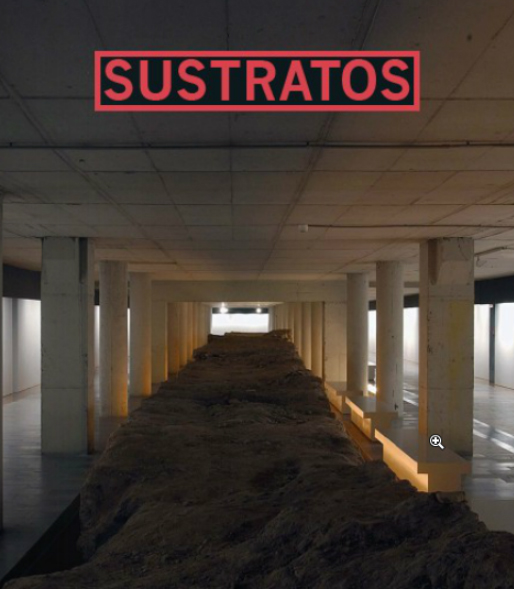
)))))))))))scrolldown for english(((((((((((
http://comisario.net/sum/ivam_
expo: _sustratos_
comisario: nilo casares
coordinación técnica: irene bonilla
organiza: ivam
lugar: sala la muralla del ivam ( http://www.ivam.es | http://goo.gl/maps/tikeS )
fechas: [28.11.13) (23.02.14]
artistas: eduardo arroyo, alberto bañuelos, carmen calvo, joan cardells, teresa cháfer, alberto corazón, ramón de soto, erró, christopher makos, natividad navalón, miquel navarro, vicente ortí, jose antonio orts, vicente peris, julio quaresma, sanleón, fco. sebastián nicolau, javier velasco, bernar venet, j. mª. yturralde, juan carlos rosa casasola, paola ruiz moltó, señor cifrián, mar domínguez, regina quesada, irene grau, trashformaciones, jimpunk, marie-lou desmeules, andrea gussi, marcos juncal, samuel ortí, für alle falle, salvia ferrer, carla cruz, daniel grijalba, solimán lópez, rocío garriga, eva and franco mattes, volkan diyaroglu
:::::::::::::texto del catálogo:::::::::::::
dobles parejas sin descartes
richard: (…) tal vez seas más suya que mía.
bertha: no lo soy. pero también siento algo por él.
richard: y yo igual. puedes ser suya y mía. yo confiaré en ti, bertha, y en él también; tengo que hacerlo. no puedo odiarle porque sé que sus brazos te han rodeado. tú has hecho que nos acerquemos más. en tu corazón hay algo más sabio que la sabiduría. ¿quién soy yo para llamarme dueño de tu corazón, o del de cualquier mujer?. bertha, ámale, sé suya, entrégate a él si lo deseas… o si puedes.
bertha (en tono soñador): me quedaré.
richard: adiós.
joyce, j: exiliados
traducido por fernando toda
madrid. 1987. págs 145, ss.
en el póquer existe la figura de las dobles parejas, una posición en el juego situada entre la pareja y el trío; esta forma me gusta porque sin ser nada concreto no despareja a la pareja, que en el fondo solo es una con la que no vas a ninguna parte, y te evita la pesadilla que supone un trío de lo que sea (en ese sentido, el dicho español de tres son multitud acierta por completo) y por eso en esta exposición se ha seguido el principio de emparejar a unos con otros sin descartar a nadie; por más que esto resulte una dificultad enorme, o todo lo contrario, dada la extensa colección del ivam y así sustratos es una exposición que comienza sin problema complicación y termina siendo un carrusel, facilitado tanto por la propia arquitectura de la sala, más dada a recorrerla sin fin que con paso a favor, o contra, las agujas del reló, como por la inagotable colección que alberga el ivam.
esta iniciativa de la dirección del ivam, para destacar el arte realizado por aquellos artistas que por edad carecen de presencia en su colección en contraste con otros que sí, surge porque no se conforma con ensimismarse en su colección para que veamos hasta dónde ha llegado el arte en valencia, consciente de que lo mejor está por venir y lo hará desde otras partes. por eso, cuando me adentro en la exposición lo hago a partir de mi circunstancia de un residente en valencia que no es de aquí, estatuto que me permite atender la pluralidad de orígenes que tienen todas las manifestaciones artísticas pero también los propios artistas.
al golfo de valencia han arribado las personas y las mercancías desde siempre y de todas partes; de la misma forma, unos se quedan, otros se nutren de lo que hay aquí y se marchan, no pocos vienen y van, en una relación pendular con la ciudad que resulta enriquecedora para todos, mientras algunos nacen y se largan porque aquí no pintan nada, y muchas otras maneras de vincularte al lugar entre la que no cabe olvidar el fuerte prestigio de sus dos máximas instituciones artísticas actuales, su facultad de bellas artes y el ivam, aunque tampoco puede ignorarse su temprana galerística contemporánea, que ahora parece volver a tomar impulso para ponernos a todos, otra vez, en órbita.
entre unas cosas y otras, un instituto de arte moderno no puede ignorar las relaciones fluctuantes de muchos artistas que no siendo valencianos de origen, lo son en la actualidad o lo fueron en algún momento, como la misma colección del ivam no se limita a recoger artistas de origen valenciano, lo cual atentaría contra su primera obligación de educar nuestra sensibilidad para extenderla e ilustrarnos en lo que el mundo ha sido y está sucediendo.
la exposición también trata de descubrir esas filiaciones que siempre se dan en el arte porque nihil sub sole novum y durante mucho tiempo los museos fueron lugares de peregrinación artística hasta los que se acercaba la gente que quería aprender de los maestros y repetían sus enseñanzas al margen de unos talleres a los que no podían acceder porque quedaban fuera de su alcance. hoy esa función no solo la cumplen los museos o las facultades de bella artes, también las exposiciones temporales pueden marcar la trayectoria de un artista en formación, o incluso de alguno ya consolidado, como la convivencia con otros artistas determina el camino a seguir.
todas esas cosas están detrás de las obras de arte de siempre, como en las de hoy, y se pueden encontrar en los emparejamientos que se establecen aquí para llevar al visitante por un panorama del arte actual vinculado a valencia a través de artistas que pueden no estar hoy aquí, pero sí estuvieron, o van a dejar de estar porque se les presenta la oportunidad de desarrollar su obra en otros lugares y continúan de paso por esta vida, como lo estamos todos.
en esta introducción no voy a referirme en ningún momento a los artistas de la colección ya que por su estatus son de sobra conocidos y, puesto que la intención fundamental de sustratos es dar pie a las obras nuevas realizadas por los nuevos, será a ellos a quien me dedique.
el emparejamiento, en algunas ocasiones, fue realizado por la vinculación con el país de residencia de la obra presente en el ivam tomada como disculpa para mostrar la obra de artistas cuya relación con valencia no es tal.
así ocurre con la obra de eva and franco mattes que fueron expuestos en la galería punto en el año dos mil dos, en una colectiva titulada punto.dot que trataba de reflejar el arte digital que se estaba fraguando en esos momentos, en aquella ocasión esta pareja, entonces un grupo, firmaba 0100101110101101.org. se proyecta esta película, por su condición actual de residentes en nueva york, como el artista con quien se emparejan. let them believe (dirigida por todd chandler y jeff stark, y para la que también han contado con la ayuda de ryan c. doyle y steve valdez) documenta un complejo proyecto, plan c, en el que se introdujeron en la ciudad de chernóbil pertrechados de todo tipo de protecciones para librarse de la contaminación radiactiva y desvencijar parte de la chatarra que fueron encontrando por esta pompeya moderna; algunos de sus restos se introdujeron de matute en el reino unido y con ellos se construyó un tiovivo para contribuir al solaz de un parque público londinense, que carecía de ese juego que a todos nos gusta, en una zona no muy principal de esa ciudad. los vínculos de los mattes con el apropiacionismo, la provocación y la denuncia de situaciones estúpidas, incluso en la propia historia del arte último, es de sobra conocida.
otro apropiacionista irredento, que viene al caso por su condición de residente en parís (o eso creo porque de este artista nadie sabe nada), la ciudad en que vive el autor con el que emparenta su obra, es jimpunk, un artista de los primeros momentos del net.art que utiliza todo tipo de herramientas de la navegación digital y en todas sus formas, tanto las de la internet 1.0, como todas las versiones de lo que ahora se llama redes sociales (o 2.0) para establecer un discurso en el que prima el ruido para hacernos ver que no hay nada más allá y que estamos atrapados por unos cachivaches con los que suponemos tomar unas decisiones que no son más que las que, como de costumbre, otros toman por nosotros (el golpe del clic sobre la pantalla para llevarte a otra parte sería la forma más banal, y que desde un primer momento este artista suprimió de sus trabajos). la obra aquí expuesta, trptch 01011, es un vómito sin concesiones capturado el catorce de mayo de dos mil once, de las muchas cosas que internet andaba soltando por ahí, entre las imágenes se encuentran algunas realizadas por el autor, pero el conjunto es pura remezcla sin pies ni cabeza, como todo lo que anda por esa internet de la que nos sentimos tan dueños y que ha venido aquí para liberarnos.
el apropiacionismo, llevado a la emulación de otros comportamientos, se encuentra en la obra de carla cruz que tampoco tiene otra vinculación con valencia que su condición portuguesa, como su pareja. la obra expuesta, una edición de tres mil tarjetas postales que el visitante puede llevarse como recuerdo de su machada, recoge la performance ser artista em portugal é um acto de fé, ejecutada en el año dos mil tres cuando se lanzó, con el pelo cortado a lo chico, desde el puente de don luís (oporto, portugal), al agua del río duero para ostentar su valentía como artista tras arrojarse desde una altura tan elevada; se comprende mejor la obra sabiendo la costumbre, entre los jovenzuelos portuenses, de saltar desde ese puente para demostrar su hombría y fardar de valentía frente al resto de chavales. con esta performance la artista quiere demostrar que tiene el mismo valor que ellos, si no más, y se lanza al mundo del arte sin miedos. en estos momentos, a ningún lector se le escapará la ubicación de la autora en un feminismo crítico, aunque en su caso no solo lo es con la atribución de papeles de género, sino que profundiza en las posibilidades de un arte cuya recepción sea realmente democrática y, por eso, en esta expo te llevas su hazaña a casa.
pero vengamos más cerca de la mano de juan carlos rosa cassasola que es natural de benidorm, algo así como no ser de ninguna parte (tengo un amigo nacido en las vegas y lo que este cuenta de allá es lo que aquel cuenta de aquí); resulta envidiable ser de un sitio cuya distinción es no tenerla, quizá por ello su obra sea tan desprejuiciada y al loro de la realidad actual, porque lo importante es con quién compartes el plato, no de qué está lleno, xxv pertenece a una serie que revisa la caterva de cachivaches, otra vez, con que nos estamos socializando, pero desde las técnicas tradicionales de registro, algo nada baladí ya que desde la representación bidimensional podemos parar con mayor profundidad a ver qué supone cada uno de los iconos (y no solo los iconitos que representan utilidades de los cacharros, sino también los tópicos en boga en cada momento) que te van lanzando esos dispositivos con que estás en comunidad (ya sabéis, las redes sociales o 2.0); porque de qué te vale saber que ahora esto mal, aquello peor, y lo otro fenomenal, si a la gente con quien estás consumiendo tópicos e iconos no la conoces más que de una forma superficial, es decir, bidimensional, que es el freno pictórico con que el autor para tanta trepidación.
la realidad en que nos encontramos deja de lado a la naturaleza real de las cosas y por eso viene en nuestro auxilio, desde alicante, paola ruiz moltó, quien prima la reflexión sobre el vacío, la ausencia, que es una preocupación característica a la escultura, como también lo es la relación que mantenemos con los espacios; sería interesante investigar si fue primero la escultura o la arquitectura, para esta artista no cabe la menor duda, se sitúa en una suerte de ‘arquiescultura’ (la expresión es suya) con la que resuelve todos estos conflictos e incluso se eleva sobre el pensar antiguo que contrapone la dureza de la piedra a la caricia de una mano, donde una es rotunda la otra abre mil posibilidades, y así se permite lujos como arar campos de trigo en el secarral de una sala de exposiciones; porque con esa naturaleza (que no parece entrar en las habitaciones, pues la arquitectura, como obra rotunda del hombre, siempre es lo contrario a la naturaleza y en el caso de esta artista, bajo la forma de ‘arquiescultura’ blanda) es como salva las distancias con respecto a un mundo del que nadie consigue bajarse en medio de la velocidad de la luz que nos envuelve y así el refugio que nos trae hasta aquí es tan cierto como necesario.
aunque no todo va a ser naturaleza, un poco de compostura nunca viene mal, que la elegancia está reñida con la naturalidad lo sabemos desde que tío oscar (wilde, of course) va por la vida. en ese sentido la obra de señor cifrián, una pareja de mujeres ocultas bajo ese rotundo señor, para complicarnos la realidad con un sinfín de equívocos, el primero de ellos, ¿qué se está representando aquí? la obra de estas artistas es un constante ahondar en las técnicas de representación, con procesos que van de la pura fotografía a la fijación de restos de humo, como si nos enviasen señales de que entre la cosa y sus indicios hay una distancia enorme; y además lo manifiestan sin ningún tipo de rubor y lo hacen expreso, como en esta ocasión con la obra perenne, una instalación que está compuesta de lo que ellas llaman una cartela que es una sucesión de los pétalos de geranio empleados para la confección de un delicado cuello de camisa masculina (de nuevo el juego con su condición de señor) en parafina que a su vez fue utilizado para la realización de una serie fotográfica que tenía a este cuello como víctima de una representación, a la que se pueden ir añadiendo elementos, ahora ya puestos por el propio fruidor, con los que indagar acerca de qué trata todo.
la vestimenta no solo es un vehículo para la elegancia, también nos protege de un entorno hostil, una segunda piel, o incluso escamas con las que sumergirnos en el mar. esta es la parte que investiga la obra de mar domínguez que a su condición de artista añade la de experimentada buceadora, sin esta adicción no se podría comprender nada de su obra; yo, que he sido buceador, conozco muy bien la afición dominguera de los buceadores a fotografiar los fondos marinos y su fauna, un poco como el turista de cruceros te castiga con su salida al mar a su regreso. este no es el caso, no estamos ante una dominguera que se cuelga con el paseo de un mero o la escapada de un pulpo, no, se trata de un proceso introspectivo sobre la situación que supone para el hombre estar metido bajo el agua y seguir respirando, es algo que no me había encontrado hasta ver la obra de esta artista; siempre que ves una expo de arte subacuático te enfrentas a tópicos, ahora la reflexión es sobre la relación con el medio hostil para el que te pertrechas de tecnología punta y sales indemne de unos vuelos bajo el agua que serían imposibles, y ello gracias a unos equipos sin los que no podría existir este respira, al que superpone los pulmones del padre de la artista en sus horas bajas.
oparín sitúa el origen de la vida en eso que llamó un caldo primigenio que no es otra cosa que la mar y en el que se fueron formando unos primeros proto-organismos vivos a los que llamó coacervados. algo parecido a esos coacervados son los seres primitivos que nos presenta regina quesada y que titula de modo genérico le primitif. estos seres realizados con elementos tan primarios como son el grafito y unas resinas muy delicadas y sensibles, tanto a la luz como a la temperatura y el tacto, son perfilados al azar de la misma manera que los coacervados iban dejándose llevar por el oleaje (así lo quiero imaginar yo) y se encontraban por casualidad unos con otros, fruto de esos choques se producían formas más complejas y si continuamos las tesis de oparín nos veríamos a nosotros mismos comenzando en purititos coacervados. sustituyamos el caldo primigenio y los coacervados por la mano de la artista y el papel que la recibe para seguir su proceso compositivo hasta ir dando con estos seres frágiles, mucho, tanto que exigen la máxima protección para ser expuestos, y descubriremos, al final de todo, ese rompecabezas que es un subconsciente preñado de unas intuiciones que están a flor de la piel de los dedos que dibujan.
el caldo primigenio tenía un rasgo que no conviene olvidar, era cálido, y no puede haber calor sin una luz que lo irradie, sobre esta luz es sobre la que trata toda la pintura de irene grau; para quien se enfrente a su obra magenta, amarillo y cian, tal vez parezca osado hablar de pintura ante esta instalación. todo el proceso de análisis de esta artista versa sobre el verdadero ser de la pintura y le conduce a un camino, parece que sin retorno, de inmersión en la naturaleza de la luz. si se observa con atención, y más en una ciudad radiante como valencia, costará poco ver que las sombras tienen color, el color que le otorgan los objetos sobre los que incide la luz, esa perspicacia en el mirar es la que quiere trasladar la artista a esta instalación realizada para esta expo y que nos ayuda a comprender cómo la luz emitida desde tres fuentes de colores básicos va llenando de color el espacio, pero no solo de tres colores, sino de más porque a la primera luz se añade una sombra y a esta otra, que además se entrecruza con otra y nos potencia la presencia de los colores hasta ocupar todo el espacio bidimensional que tenemos enfrente; nos llena la pared, el lienzo, de luz porque lo está inundando de pintura, y para que lo notes mejor, mete el dedo.
la luz no pesa nada, no así la pintura, pero si algo pesa sin discusión es la chatarra, y a eso se dedica el dúo trashformaciones, unos hermanos chatarreros cuyo origen es la negación del negocio familiar. al principio se propusieron metas mayores, como la arquitectura o el diseño industrial, después de renegar de esos caminos mejor vistos, volvieron sobre el negocio familiar para asumirlo, claro que al principio no pudieron evitar sus segundos orígenes, aquellos que les llevaron a renegar por primera vez del negocio familiar, y tuvieron coqueteos, otra vez, con el diseño industrial pero desde la reutilización de las cosas que se encontraban por la chatarrería familiar de almassora (castelló). con el tiempo se libraron de complejos y se lanzaron de lleno a la producción de piezas artísticas aprovechando la fuerza del propio proceder de las técnicas de la regeneración de la chatarra, comenzándola a ver de otra manera; es como si de golpe, el fruto de su trabajo cobrara una nueva textura al ser observado bajo la óptica del distanciamiento de sí mismos, tal vez porque ellos comprenden la técnica del extrañamiento de bertolt brecht, y ello les permite asignar el rango de piel puesta a secar a piel 25, piel 26 y piel 32.
piel a la que sometemos a más de mil tratamientos para sentirnos siempre bellos y cuyo mejor ejemplo es la cirugía plástica, del que nuestro país es primer consumidor en europa. una de las líneas de trabajo de marie-lou desmeules, quebequense que en la actualidad reside en valencia, es lo que ella llama painting surgeries, unos complejos procesos performáticos bajo los que somete a un modelo a distintos procedimientos de manipulación pictórica y escultórica, de manera efímera, hasta conseguir un resultado final de probada fealdad, pero siempre con la intención crítica de poner en cuestión los modelos de belleza física en que vivimos instalados y para lo cual estamos dispuestos a todo. estos desarrollos performáticos también tienen mucho que ver con su faceta como diyéi, que es como la conocí a su llegada a valencia, con una puesta en escena muy cabaretera. pero sus inicios en el arte estuvieron en el contacto con la pintura acrílica, fue gracias a su descubrimiento que se tiró de cabeza a pintar; en su serie pizza art el acrílico es el protagonista y, además, en ella homenajea a muchas de las mujeres patrón de belleza desde el cine de los años dorados; aunque si una destaca hoy sobre las demás es kate moss.
la piel, las uñas, el cabello, contienen nuestro adn y el rastro de nuestra belleza. hace dos siglos el arte puso en entredicho ese modelo de belleza, fue en la viena que transita entre el diecinueve y el veinte, y es un lugar común destacar como protagonista principal al sigmund freud que sitúa lo unheimlich (lo ‘no familiar’) en el centro de la reflexión sobre su tiempo y máximo responsable de que artistas como egon schiele cuestionasen desde la pintura lo bello para enfrentarnos a modelos nada saludables y sí muy deteriorados, justo cuando austria sufría la mayor incidencia de tuberculosis de la historia; en ese momento se quiebra el patrón de belleza y el arte pasa a mirar hacia otro lado. sin embargo, fuera de nuestro mundillo artístico, la belleza se sigue asociando a la salud y, sobre todo, a la juventud, en ese contexto crece la defeña andrea gussi (que residió en valencia cuatro años, para cursar un postgrado en bellas artes), que por razones familiares se va a vivir a ciudad juárez y allí se ve inmersa en el femicidio masivo de jovencitas de dieciséis años a las que solo cabe atribuirles la responsabilidad de su belleza, no hay otra explicación, o no se le antoja, a la propia artista; mostrarlo sin caer en lo obvio es el reto de gráfica del desierto.
al páramo se enfrenta alguien al que el sistema educativo expulsa porque no ha lugar al estilo libre y la expresión caprichosa, no sirve dejarse llevar ni apasionarse con campos de color, lo único que vale es entrar por el aro y bajo los dictados de un magisterio entendido a la manera en que se trataba a los galeotes. esta fue la sensación que el muy niño daniel grijalba tuvo mientras iba por las aulas como corre un gamo escapando de un cazador que solo ve en uno al mejor blanco de sus disparos. apasionado pintor en ciernes, su madre alimentaba en él cada resquicio que veía de gozo en su hijo (yo también tuve una madre consentidora, así que puedo comprender muy bien las complicidades que se reunieron en su crecimiento como persona), quien se alimenta de una pasión solo puede ver lo peor en la escuela, que ha venido aquí para domarnos; así que apaga y vámonos, que es lo que este artista decidió desde una edad bien temprana; sin embargo, algo tiraba de él en su interior más profundo; si la abstracción es algo, además del mejor reflejo del desierto en que estamos, seguro es esa fuerza que te lleva a volcar sobre la superficie pictórica toda la carga expresiva que va contigo a todas partes, estas son sus luces y sombras.
a los espacios yermos, páramos o desiertos, yo que soy de un lugar fértil, siempre lo asocio con un silencio en el que abunda más la sombra que la luz; sí, resulta contradictorio, pero a veces las contradicciones son el fiel con que medir las cosas. la suma de silencios tiene algo angustioso porque termina imponiéndose sobre las situaciones con la carga de un peso insoportable, algo así debe pensar rocío garriga cuando está dedicando todos sus esfuerzos al ‘silencio y sus ruinas’ (según me cuenta), uno de cuyos exponentes es la obra un año en minutos de silencio (del 28 de agosto de 2011 al 28 de julio de 2012), que ahora revisa con una versión del año trece para dejar más explicito algo que a mí me interesa mucho, y es que también existen enlaces muertos en internet de los que ya no podemos decir nada. el contenido de la pieza es la secuencia de todos los minutos de silencio anunciados desde el servicio de alertas del sempiterno buscador en el que todos acabamos nutriéndonos de información, sí, google; durante las fechas que señala el título la artista los recogió puntualísimamente, hoy muchos de esos enlaces están muertos, como los silencios por los que se convocaban las alertas, en un vaivén sobre el que no caben culpables.
quién fue, cómo doy con él, para eso tenemos las técnicas más sofisticadas de investigación que nos permiten encontrar al culpable, y si no me basta con lo que veo, voy más lejos y sigo sus huellas para dar con él y pillarlo, si no con las manos en la masa, al menos con todo el marrón de haber dejado impresas sus huellas dactilares, porque no todo salta a la vista y muchas de las pistas que dejamos están ocultas de primeras, como así demuestra una parte del trabajo de solimán lópez y que aquí se recoge en una selección de obras de su serie user fingerprints, que se correspondería con la línea de su producción que este artista digital, recién llegado a vivir a valencia, dedica a lo que está detrás, al backdoor en términos computacionales. entre un sector de los artistas digitales existe un interés muy fuerte por denunciar lo que no vemos que se hace con nosotros porque el gran hermano (y existe más de uno, de la misma manera que hay más de un poder que es el poder) va almacenando cada bit de información para utilizarlo, siempre, en nuestra contra, hasta el extremo de que ya existen servicios para limpiar nuestra historia pública en internet, en el gran hermano; pues antes de la aparición de internet, ya dejábamos nuestras huellas por doquier.
y por eso saben de nosotros y podemos acabar en la cárcel. salvia ferrer se metió en eso del cine porque un día fue a casa de su abuela y se quedó fascinada con la tele en colores que tenía la señora, ese día decidió dedicarse a hacer películas y puso todo su empeño en ellas. por azares de la vida se vio envuelta en un curso en la cárcel para impartir sus conocimientos a las presas, no contenta con dar sus clases también aprendió de sus pupilas y las sometió a una terapia que fue de lo más fecunda para todas, convenció a varias de ellas para entrar en un proceso de lavado de cara y maquillaje que las hiciese sentirse algo más que parias recibiendo su merecido, las convirtió en estrellas ante la cámara y las trató como tal para que contasen su devenir hasta caer en un sitio tan sórdido, selecto porque ahí no entra cualquiera, pero nada deseable, como es la cárcel de picassent. plenas de la luz que dan las cámaras y el maquillaje, nos van contando las razones de su encarcelamiento y terminamos descubriendo su doble condición de víctimas, de un sistema que condena el delito y de una sociedad que somete a las mujeres al capricho de sus varones, y eso solo lo conseguimos saber cuando les dedicamos unos retratos de luz, como si las llevásemos de fiesta.
para fiesta, la que nos trae marcos juncal, artista cuyo contacto con valencia fue muy tangencial al limitarse a intentar residir en esta ciudad, hoy vive en londres, y tomar como catapulta la galería mr. pink, donde le vi una exposición hilarante; porque si algo conviene a la obra de este artista es ese calificativo socarrón que invita a reír hasta ahogarnos; imagine el lector un botafumeiro a tamaño real (este artista es de origen gallego) realizado con espejitos de bola setentera de discoteca, titulado discofumeiro, y ya no tengo más que contar para adentrarnos en su obra; no es extraño que haya acabado en londres rodeado de los muy vacilones young british artists, aunque bien estaría decir que sus primeros estudios fueron en la muy prestigiosa escuela de escultura clásica del monasterio de poio, donde sin duda compartió aulas con quienes levantaron la catedral de santiago de compostela con golpes ciertos de cantero. vuelve a valencia su chupe-tín, chupete enorme realizado en poliéster, cuero y acero que invita a pensar en una fiesta de lederonas, a ver quién es más mala y, eso sí, más juguetona. su obra es una sucesión de trampantojos lingüísticos, nunca visuales, en los que mezcla cualquier cosa para inmortalizarla en una carcajada.
también resulta muy jocosa gran parte de la obra de für alle fälle (ella de coruña y él de valencia, donde se conocieron estudiando bellas artes), muy dados al arte de acción y a la performance bastarda, entre las obras que pueden darnos una pista sobre su trayectoria se encuentra la convocatoria de un torneo de baloncesto, torneo passión, en el que los propios jugadores decidían qué tipo de jugadas realizar e invitaban a participar a cualquiera, sobre todo si no estaba invitado, que no tuviese como meta ganar, llevando el principio de lo importante es participar al campo real de juego, porque el deporte no es un juego, es la guerra por otros medios, y en este torneo solo se buscaba jugar, divertirse. fervorosos militantes en la cultura basura tuvieron una formación paralela a la universitaria entre los centros okupados de esta ciudad y los peores bares, y tanto realizan una obra de arte como te castigan con un concierto a 8 bits. el principio de desarmar las reglas del juego para ver qué pasa se traslada a esta expo con el entresuelo (realizada en colaboración con dio3stu, y ahora reutilizada), una escultura sonora para ser tocada por cualquiera, construida con la circuitería sobrante de distintos cacharritos: toquen, toquen.
samuel ortí también es muy amigo de los cacharritos y de montarlos, quiso ser inventor, pero tenía en contra su condición de hijo de artistas, de manera que aunque intentó seguir caminos serios como los de la ingeniería, obedeció a su genética e ingresó en bellas artes, aunque su formación principal la realiza de la mano de su padre, a quien ayuda en su taller desde edad bien temprana. su padre es vicente ortí y no conozco ningún alumno que haya disfrutado de su magisterio que no hable bien de él, así que no voy a preguntarle a su hijo. este artista, me refiero al hijo, se decide muy tardíamente por realizar obras propias, y cuando lo hace es en una curiosa conjunción de sus deseos infantiles, sus estudios abandonados de ingeniería y sus tareas vicarias en el taller paterno, probado maestro en el tratamiento de la piedra; fruto de todo ello resultan trabajos, como mechanical shock, que parten de la severidad de la piedra o el acero, para insuflarles unos mecanismos automáticos que otorguen a ese rigor un movimiento impensable; en ese sentido son prodigios técnicos que se mueven entre el peso y la levedad, entre la escultura y el deseo de llegar a ser el juguete que espera todo adulto que no haya renunciado al sueño del niño.
con otro mecanismo aparece el estambulita (llegado a valencia como cobaya, al ser el primer artista turco becado por su gobierno para estudiar aquí) volkan diyaroglu. pintor de grandes formatos que dejó de jugar a conceptual a orillas del bósforo, donde inició sus estudios de bellas artes concluidos en valencia, lugar en que el conceptualismo está en todos los menús del día mientras que en su ciudad era una rareza de los restaurantes más selectos. se desenvuelve entre cuadros como una caballa por el mármara, porque de su pasado conceptual performero conserva la obsesión por llenarse de pintura hasta las cejas, como todos los que pintan sobre el suelo, y así no ver nada; pero en esta ocasión se expone su apocalyptic kebab que expresa muy bien la situación en que se encuentra no solo su país, cuyas virtudes republicanas están en retroceso frente a los valores retrógrados de unos políticos cegados por las creencias religiosas, sino todo el planeta, ya que hacia donde miremos tropezamos con pasos atrás en los valores ilustrados que hicieron de nosotros hombres de bien. ver el mundo en descomposición estocado en medio de un asador vertical, eso sí, siguiendo su eje de rotación como si nada, resulta tan clarividente como aterrador.
y todas estas obras expuestas en los sótanos del ivam, en la sala de la muralla, que es donde empezó esta ciudad, da un mayor sentido al arte que se fagocita a sí mismo para continuar vivo.
invito a rastrear los artistas aquí seleccionados en internet, google, o no, mediante.
‘ñora, ella es tan satanás que él misma. quién? anna livia? ay, anna livia. sabes que ella llamamaba chaveas napeas por tos laos, nyumba nu, chamba chu, pa trajinarlo, su percebo preboste, y papa embararlo con comio así-oasí? síi? qué sorra! yssel límmate? como la guiñada del negro cuando visoñó la plata.
joyce, j: anna livia plurabelle (finnegans wake, i, viii)
traducido por francisco garcía tortosa, fernando navarrete y josé maría tejedor cabrera.
madrid. 1992. pág. 143.
)))))))))))arriba español(((((((((((
http://comisario.net/sum/ivam_
show: _sustratos_
curator: nilo casares
technical coordination: irene bonilla
by: ivam
venue: sala la muralla del ivam ( http://www.ivam.es | http://goo.gl/maps/tikeS )
schedule: [28.11.13) (23.02.14]
artists: eduardo arroyo, alberto bañuelos, carmen calvo, joan cardells, teresa cháfer, alberto corazón, ramón de soto, erró, christopher makos, natividad navalón, miquel navarro, vicente ortí, jose antonio orts, vicente peris, julio quaresma, sanleón, fco. sebastián nicolau, javier velasco, bernar venet, j. mª. yturralde, juan carlos rosa casasola, paola ruiz moltó, señor cifrián, mar domínguez, regina quesada, irene grau, trashformaciones, jimpunk, marie-lou desmeules, andrea gussi, marcos juncal, samuel ortí, für alle falle, salvia ferrer, carla cruz, daniel grijalba, solimán lópez, rocío garriga, eva and franco mattes, volkan diyaroglu
:::::::::::::text of catalogue:::::::::::::
two pair without discards
richard: (…) you may be his more than mine.
bertha: i am not. only i feel for him, too.
richard: and i do too. you may be his and mine.
i will trust you, bertha, and him too. i must. i
cannot hate him since his arms have been
around you. you have drawn us near together.
there is something wiser than wisdom in your
heart. who am i that i should call myself master
of your heart of of any woman’s? bertha, love
him, be his, give yourself to him if you desire – or
if you can.
bertha (dreamily): i will remain.
richard: goodbye.
joyce, j: exiles
the figure of two pair exists in poker, a position in the game in between a pair and three of a kind. i like this form, because without being anything specific, it doesn’t unpair the pair, which ultimately is just one which you go nowhere with, and it saves you from the nightmare any trio implies (in that sense, the spanish proverb “three is a crowd” is totally right) and that is why in this exhibition we have followed the principle of pairing one with another without discarding anybody. this might seem extremely difficult, or the opposite, given the ivam’s extensive collection. therefore, sustratos is an exhibition with an easy start off which ends as a complete carousel, helped by the architectural nature of the hall, which encourages the viewer to stroll around it rather than to visit it clockwise or counter clockwise, and by the endless collection the ivam holds.
this initiative promoted by the ivam’s management, to highlight the work of artists not present in the collection due to their age in contrast with others present in it, has the intention of shedding light not only on its collection and on what goals valencian art has accomplished, given that we consider the best is yet to come, and it will from elsewhere. that’s why when i enter the exhibition i do so as a resident of valencia which is not from here, status which allows me to focus on the diverse origins of all artistic expressions, but also on the artists themselves.
people and goods have been arriving at the gulf of valencia for ever and from everywhere. some stay, others nourish on what is here and then leave, quite a few come and go in a pendulous relation with the city which is beneficial for all, while others are born and take off because they can’t find their place here. there are many more ways of establishing a link with a place, so we should not forget about the high prestige of both of valencia’s greatest artistic institutions, its faculty of fine arts and the ivam, not to forget its early tradition for contemporary art galleries, which appears to be gathering momentum again, to put us all once more in orbit.
between one thing and another, an institute of modern art can not ignore the fluctuating relations of many artists who are not originally from valencia, but are valencian now, or have been some time. in the same way, the ivam’s collection does not limit itself to artists of valencian origin, because it would infringe upon its fundamental obligation of extending our sensitivity to spread it and acquire knowledge on what the world has been and what is happening within it.
the exhibition also tries to reveal the ever present filiations in art because, nihil sub sole novum, for a long time, museums were places of artistic pilgrimage. in them, people with a desire to learn from the masters would gather and then try to repeat their teachings away from the workshops which they had no access to. now a day, that role is not only carried out by museums and fine arts faculties. temporary exhibitions can also mark the careers of forming artists, or even of those already well established, in the same way daily coexistence determines the path to follow.
all of those things are behind lifelong art works, as in today’s, and they can be found in the pairing established here to drive the visitor through a vision of present art linked to valencia through artist that may not be here today, but were in some time, or they are no longer going to be here because they have the opportunity to develop their work elsewhere, and they go on with their lives as we all do.
in this introduction i will not mention any of the artists in the collection, because due to their status they are already widely known, and given the main objective of sustratos is to give way to new works created by new artists, i will focus on them.
the pairing was sometimes made by the connection with the country of residence of the work present in the ivam, and taken as an excuse to display the work of artists which connection with valencia does not exist.
it happened with the work of eva and franco mattes, exhibited at the punto gallery in the year two thousand and two in a display titled punto.dot with the intention of reflecting the digital art being developed at the time. in that occasion this pair, back then a group, would sign 0100101110101101.org. this movie is shown due to their current status of new york residents, like the artist with whom they are matched. let them believe (directed by todd chandler and jeff stark, with the help of ryan c. doyle and steve valdez) documents a complex project, plan c, where they entered the city of chernobyl equipped with all types of protection to avoid radioactivity and dismantle part of the junk they found in this modern pompey. part of the wreckage was smuggled into the united kingdom and used to build a merrygo-round, to contribute to the peace of a public park in london which did not have that specific ride we all enjoy, in a non central part of the city. the links between the mattes and appropriationism, provocation and the denouncement of stupid situations, even in our own late history of art, is well known.
another unrepentant appropriationist, related to this because of his
condition of paris resident (or that’s what i believe, because nobody knows anything about this artist), the city where the author lives and relates his work to, is jimpunk, an artist belonging to the beginning of net.art who utilises all sort of digital browsing tools in all of its forms, both 1.0 internet as well as what are known today as social networks (or 2.0), to establish a discourse in which noise prevails to make us understand there is nothing beyond that, and that we are caught up in junk through which we think we are making decisions which are no more than, as usual, decisions taken by others (a click on a screen to take you elsewhere would be its most banal form, eliminated by the artist from the beginning). the work displayed, trptch 01011, is a hurl without concessions captured on the 14th of may of 2011 amongst many others released by the internet everywhere. within these images, we can find some created by the author, but the grouping itself is a pure mix with no sense whatsoever, the same as everything we can find on the internet, which we feel belongs to us and is here to liberate us.
appropriationism, taken to the imitation of behaviours, can be found in carla cruz’s work, which has no other connection with valencia than being portuguese, like her partner. the work exhibited, an edition of three thousand post cards which can be taken home by visitors as a reminder of this brave act, shows the performance ser artista em portugal é um acto de fé (being an artist in portugal is an act of faith) carried out in 2003 when the artist jumped off the don luís bridge (porto, portugal) with a male haircut into the waters of the douro river to prove her courage as an artist after jumping from such height. one can understand the work better after realising the habit porto youngsters have of jumping off that bridge to prove their manhood and to boast about their courage with the rest of the kids. with this performance, the artist wants to prove she is as brave as them, if not more, diving into the world of art with no fear. right now, nobody will doubt of the critical feminist position of the artist, although in her case, she is not only so by means of her attribution of genre roles, but she delves in the possibilities of a truly democratically perceived art. this is why you can carry her great feat home from this exhibition.
but let’s come closer by the hand of juan carlos rosa cassasola from benidorm, which is something similar to being from nowhere (i have a friend born in las vegas who says the same). it is enviable to be from a place which distinction is not having any, perhaps that is why his work is so unprejudiced and aware of current affairs, because lo importante es con quién compartes el plato, no de qué está lleno, xxv (what is important is who you share your plate with, not what is it full of, xxv) belongs to a series which again goes over the great quantity of junk with which we socialise, but through traditional representation techniques, a non petty fact given that by means of twodimensional representation we can deeply analyse what does each of the icons mean (and not only the little icons representing junk’s utility, but also the du jour stereotypes) delivered to us by those devices with which we live (you know, social networks or 2.0). so, what good is it to know this is wrong, that is worse and that other thing is great, if you don’t know the people with whom you share topics and icons more than in a superficial way, that is, twodimensional, which is the pictorial break with which the artist stops so much freneticism.
the reality we are in puts aside the real nature of things. this is why paola ruiz moltó comes to our rescue from alicante, prioritising a reflection on emptiness and absence, which is a concern characteristic to sculpture, in the same way our relationship to space is too. it would be interesting to investigate what came first, architecture or sculpture; there is no doubt for this artist, given that she positions herself in some sort of “archisculpture” (her expression) with which she solves all those conflicts, rising over ancient thinking to oppose the hardness of a rock with the caress of a hand. while one is straight forward, the other offers thousands of possibilities, allowing the artist to afford luxuries such as ploughing wheat fields in the dry plains of an exhibition hall; because with this nature (not present in rooms, because architecture, as man’s direct creation, is always opposite to nature, and in this artist’s case, under the form of soft “archisculpture”) she bridges the gaps with a world nobody is able to get off of within the speed of light which surrounds us. therefore, the refugio (refuge) which leads us here is as true as necessary.
although not everything is nature, a bit of composure is never a bad idea. we know elegancy is at odds with naturalness since uncle oscar (wilde, of course) roams through life. in that sense, señor cifrián’s work, a pair of women concealed beneath the title of señor (sir), to complicate reality with endless misunderstandings. the first of which is: what is being represented here? the work of these artists is a permanent delve into representation techniques, with processes ranging from pure photography to the fixation of smoke remainders, as if they issued signs of the existing distances between things and their signals. furthermore, this is shamelessly manifested in this occasion making it explicit, like with the work perenne (eternal), an installation composed by what they call a placard, which is a succession of geranium petals used in the making of a delicate men’s shirt collar (once again, the word game with their condition of señor) made of paraffin once used for the creation of a photography series with this collar as an object of representation, which can have elements added to, and now put in by those who enjoy it, with whom to enquire what it’s all about.
clothing is not only a vehicle for elegancy, it also protects us from a hostile environment, a second skin, or even scales with which to submerge ourselves under the sea. this part investigates the work of mar domínguez, who besides being an artist is also an experimented scuba diver. without this addiction her work could not be understood. i have been a scuba diver, so i am fully aware of scuba divers passion for taking pictures of the sea floor and its fauna, kind of like how a cruise tourist will punish you with sea excursions once he is back. but this is not the case, we are not before a sunday day-tripper addicted to the showing off of his grouper nor the sighting of an octopus, no, it is about a process of introspection on the condition of being under water and breathing, it is something i had never encountered until i witnessed the work of this artist. whenever you see an exhibition of under-water art you face clichés. now the reflection is about the relation with a hostile environment, for which you equip yourself with cutting edge technology and you escape unharmed from impossible under-water flights, and all thanks to equipment without which respira (breathe) could not exist, to which she superimposes her father’s lungs when he was not at his best.
oparin places the origin of life in what he called an original breeding ground, which is nothing but the sea, where the first living proto-organisms he named coacervates were formed. something similar to those coacervates are the primitive beings presented to us by regin quesada, and generically called le primitif (primitive). these beings created with primary elements such as graphite and resins, very delicate and sensitive to light, temperature and touch. they are outlined randomly in the same way coacervates were dragged by tides (or that is how i want to picture it) and casually bumped in to each other. as a consequence of these encounters, more complex forms were created, and if we pick up on oparin’s thesis, we could find ourselves beginning as little pure coacervates. let’s replace our original breeding ground and coacervates with the artist’s hand and the paper it lands on, to follow her creation process until we encounter these very fragile beings, to such an extent they require maximum protection to be exhibited, and we will finally discover the jigsaw puzzle of a pregnant subconscious of intuitions which are close to the surface of the drawing fingers.
the original breeding ground had a feature we should not forget: it was warm. and there can be no warmth without a light radiating it. all of irene grau’s paintings are based on this light. whoever faces her work magenta, amarillo y cian (magenta, yellow and cyan) can feel baldness considering this installation as painting. the artist’s whole process of analysis is about the real being of painting, driving her through a path, with no apparent return, of immersion in the nature of light. if one stares carefully, and even more in such a radiant city as valencia, it will not be tough to realise shades have colour, the colour they receive from the objects over which light falls. sagacity in observation is what the artist wants to transfer to this installation created for this exhibition and which helps us to understand how the light emitted from three sources of basic colours gradually fill the space with colour. but not only three colours, but many more, because a shade is added to the first light, and another shade is added to the former, which is at the same time crossed with another, boosting the presence of colours occupying the whole two-dimensional space before us. it fills the wall and canvas with light because it is flooding it with paint, and for you to feel it better, stick your finger in.
light is not heavy, but paint is. but if something is undoubtedly heavy, it is metal scrap, and this is what the duo trashformaciones does, two scrap dealing brothers whose origin is the denial of the family business. in the beginning they proposed themselves higher goals such as architecture or industrial design. after giving up on those well considered careers, they returned to the family business to make it their own, although it was difficult for them to forget their second backgrounds, those which led them to give up on the family business the first time, and they flirted, once more, with industrial design, but through the reusing of things they would find in their family junkyard in almassora (castellón). after some time, they got rid of their complexes and they fully dedicated themselves to the production of artistic pieces, taking advantage of the techniques of scrap regeneration, starting to look at it with different eyes. it is as if all of a sudden the product of their work acquired a new texture as it was observed under the perspective of self distancing, perhaps because they understand bertolt brecht’s alienation effect technique, allowing them to allocate the skin rank left for drying at piel 25, piel 26 y piel 32 (skin 25, skin 26 and skin 32).
skin we submit to more than a thousand treatments to always feel beautiful, example of which is plastic surgery, being spain the leading consumer of these procedures in europe. one of marie-lou desmeules’ lines of work, a quebecois currently living in valencia, is what she calls painting surgeries, complex performance processes under which she submits a model to different procedures of pictorial and sculptural manipulation, in an ephemeral way, until she reaches a final result of true ugliness, but with the critical intention of questioning physical beauty role models in which we live and for which we are willing to do anything. these performance developments have a lot to do with her role as a dj, which is how i met her when she came to valencia, in a very cabaret like staging. but her beginnings in art were linked to acrylic painting, and it was thanks to her discovery she decided to jump head first into painting. in her series pizza art acrylic is the main character, and furthermore, in it she pays a tribute to many of the beauty models since the years of the golden age cinema, although if one stands out over the rest that is kate moss.
skin, nails and hair contain our dna and a trace of our beauty. two centuries ago, art questioned that beauty standard, and in the vienna of the turn from the nineteenth to the twentieth century, a common ground to highlight the main character where sigmund freud situates his unheimlich (what is unfamiliar) as a cornerstone of his reflection on that time’s society, being responsible for artists such as egon schiele to question beauty from painting to face us with not very healthy and extremely deteriorated models, just at a time when austria was suffering the highest amount of tuberculosis in its history. in that moment, beauty standards are torn apart and art starts looking another way. however, outside our artistic sphere, beauty keeps on being associated with health, and especially with youth. this is the context in which the mexican artist andrea gussi was brought up (who lived in valencia during four years while she studied a fine arts postgraduate), moving to ciudad juárez for personal reasons and finding herself involved in the massive feminicide of teenage girls whose only responsibility was their beauty, having the artist no other explanation, or there being any. trying to show this without being too obvious is the challenge undertaken by gráfica del desierto (desert graph).
whoever is expelled from the education system encounters the wasteland, because there is no place in it for freestyle and wilful expression, there is no use in going with the flow or really liking colour fields, the only thing useful is to bow down to the faculty’s orders which function in a galley slave type manner. this was the feeling daniel grijalba had as a kid while he ran through the classrooms like a deer fleeing from a hunter who only considers you the best of his targets. passionate impending painter, his mother stimulated every single bit of joy she saw in her sun (i also had a very indulgent mother, so i can very well understand the complicities gathered throughout his personal growth), whoever feeds on a passion can only see the worst in school, which is here to tame us. so let’s call it quits, which is what this artist decided from a very early age. however, something deep inside was dragging him. if abstraction is something besides the best reflection of the desert we are in, there is no doubt the force driving you to lay on the pictorial surface the entire expressive load you carry everywhere, these are his luces y sombras (lights and shades).
for i who come from a fertile place, i always associate wastelands, barrens or deserts with a silence in which there are many more shades than lights. yes, it may be contradictory, but sometimes contradictions are like measuring rods. the collection of silences is somehow distressing because it ends up imposing itself over situations with the weight of an unbearable load. rocío garriga must think something like this when she is dedicating all her efforts to “silence and its ruins” (according to what she has told me), exponent of which is the work un año en minutos de silencio (del 28 de agosto de 2011 al 28 de julio de 2012) (a year in minutes of silence [from august 28th 2011 to july 28th 2012]), revised by this exhibition with a 2013 version to make even more explicit something i am highly interested in. there are dead links on internet we cannot say anything about. the content of the work is the sequence of every minute of silence announced from the alerts system of the eternal search-engine we all use to feed ourselves with information. yes, google. during the dates indicated in the title the artist punctually registered them, today many of those links are dead, like the silences through which the alerts were issued, in a constant movement with no space for guilt.
who was he? how can i find him? that is why we have the most sophisticated investigation techniques to help us find who is responsible, and if i don’t have enough with what i see, i keep on going and follow his track to find and capture him, if not red-handed, at least with the mess of leaving his fingerprints, because not everything is evident and many of the leads we leave are hidden at first sight, like proven by a part of solimán lópez’s creations grouped in a selection of works from the series user fingerprints, corresponding to part of the production this digital artist, recently installed in valencia, dedicates to what is behind, the backdoor in computer terminology. there is a strong interest within a part of digital artists in denouncing what is done to us and we don’t see because big brother (and there is more than one, in the same way there is more than one power which is the power) registers every bit of information to always use it against us, to the extent that services to clean up our public history on the internet, on big brother, already exist. well then, long before the existence of internet, we were already leaving our footprints all around.
that is why they know about us and we can end up in prison. salvia ferrer got into movies because she went to her grandmother’s house one day and she was fascinated with the colour tv the lady owned. that day she decided to make movies, and she put all of her effort into them. as chance would have it, she saw herself involved teaching a class to female inmates in prison. but not satisfied with that, she also learned from her students and submitted them to a therapy which was highly fruitful for all. she convinced a number of inmates to start a makeup and face-lifting process to make them feel something more than social outcasts getting what they deserve. in front of the camera she turned them into stars and treated them as such for them to tell the stories of how they ended up in such a sordid place, and select, because not everyone gets to go into a place like that, but not desirable, as the picassent prison is. full of light from the cameras and the makeup, they tell us the reasons for their incarceration and we end up discovering their double condition of victims, of a system which condemns misdemeanours and of a society which submits women to men’s whims, all of which we only find out when we dedicate them unos retratos de luz (light portraits), as if we were taking them out to party.
for parties, the one brought to us by marcos juncal, artist whose contact with valencia was very superficial limiting himself to an attempt to live in this city, he lives in london today, and to use mr. pink gallery as a catapult, where i saw a hilarious exhibition by him. because if something is proper to this artist’s work, is the cunning adjective which invites us to laugh until we choke. i would like the readers to picture a real size thurible (this artist is galician) made up of little disco ball mirrors from the seventies, titled discofumeiro (discothurible), and that is all i have to say to introduce ourselves in his work. it is not surprising he ended up in london surrounded by the funny young british artists, although it is also worth noting that he first studied in the prestigious school of classic sculpture at the poio monastery, where he shared classrooms with those who raised santiago de compostela’s cathedral with the technique of fine stonemasons. his chupe-tín, a huge baby’s dummy made out of polyester, leather and steel which makes us imagine a party of leathermen, let’s see who behaves worse, and of course, is more playful. his work is a succession of non visible linguistic trompe l’oeils in which he mixes anything for it to be immortalised in a laugh.
part of für alle fälle’s work is also very funny (she is from a coruña and he is from valencia, where they met studying fine arts), very inclined towards action art and performances. amongst works that can give us clues of their career we find the setting up of a basketball tournament, torneo passión (passion tournament), in which the players themselves decided what plays to carry out and invited anyone to participate, especially if they were not invited, and their goal was not to win, taking the principle of “what is important is to participate” to the real playing ground, because sport is not a game, it is a war through different means, and the only goal of this tourney was to play, to have fun. fervent militants in junk culture, they experienced a parallel education to university amongst the squat houses and the worst bars in town, and they can both create a work of art or punish you with an 8 bit concert. the principle of dismantling the rules of the game just to see what happens is transferred to this exhibition through el entresuelo (mezzanine) (created with the collaboration of dio3stu, and now reutilised), a sounding sculpture that can be touched by anyone and built with the left over circuits from different little pieces of junk: touch, touch.
samuel ortí is also a friend of these little pieces of junk, and he likes putting them together. he wanted to be an inventor, but his condition of artist’s son played against him, so despite trying to follow a serious path such as engineering, he listened to his genetics and got into fine arts, although he received his main education from his father, whom he helped in his workshop since he was a little kid. his father is vicente ortí, and i haven’t met a single student of his which had something negative to say about him, so i am not going to ask his son. this artist, i mean the son, decided to make his own works very late, and when he did, he did so in a curious conjunction of his childhood wishes, his abandoned engineering studies and his vicarious tasks in his father’s workshop, a proven master in the treatment of stone. as a product of all of this we have works like mechanical shock which start in the severity of stone or steel, to acquire automatic mechanisms granting that rigorousness with an unimaginable movement. in that sense, they are technical wonders ranging between heaviness and lightness, between sculpture and the desire of being the toy every adult who has not given up his boy dreams expects.
the istanbul artist volkan diyaroglu appears with a different mechanism (after arriving at valencia as a guinea pig, given he was the first turkish artist with a grant by his government to come study here). large format painter, he stopped playing conceptual by the shores of the bosporus, where he started his studies of fine arts which he would conclude in valencia, place where conceptualism is in daily menus compared to his city where it is something rare only present in the most exquisite restaurants. he handles himself amongst paintings like a mackerel in the marmara sea, because he keeps, from his conceptual and performist past, an obsession for getting full of paint, like everyone who paints on the ground, and not seeing anything. in this occasion his apocalyptic kebab is exhibited, expressing perfectly not only the situation his country is in, which republican virtues are in a clear set-back due to the reactionary ideas of politicians blinded by their religious beliefs, but the whole world, because wherever we look we encounter set-backs in the illustrated values which have made us good people.
and all of these works exhibited in the basements of the ivam, in la sala de la muralla hall, where the city started, gives a greater sense to the art which consumes itself to remain alive. i encourage the tracking of the artists that have been selected on internet, using google, or not.
shyr she’s nearly as badher as him herself. who? anna livia? ay, anna livia. do you
know she was calling bakvandets sals from all around, nyumba noo, chamba choo,
to go in till him, her erring cheef, and tickle the pontiff aisy-oisy? she was? gota por
yssel that the limmat? as el negro winced when he wonced in la plate.
joyce, j: finnegans wake (198.9-14).
Sustratos_IVAM / 28 November 2013 - 23 February 2014
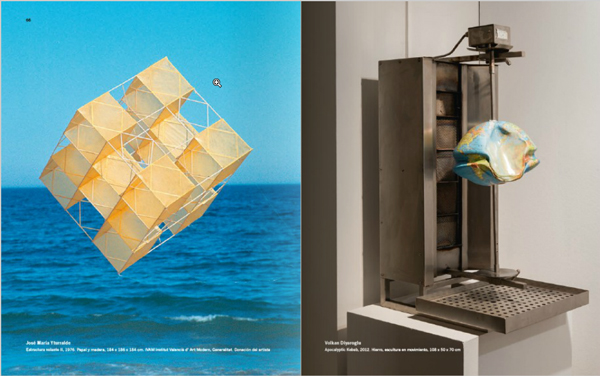
propia colección con el fin de difundir su acervo artístico consolidándose como
su mejor catalizador. Su título alude tanto al interés por vincular la
superposición de los distintos estadios artísticos que suceden en nuestra ciudad
como al lugar en que discurre esta exposición: la sala de la Muralla, desde la
que el IVAM enlaza su propia modernidad con la tradición de su ciudad de
acogida (como custodio de la antigua muralla) y por extensión, con toda la
contemporaneidad.Read more
Alienation / Estrangement – Elgiz Museum of Contemporary Art

a very democratic painting 3 247X147 cm mixed media on canvas 2011 Elgiz Museum of Contemporary Art Collection
Alienation / Estrangement
22 January – 3 May 2013
Elgiz Museum of Contamporary Art, Istanbul, Turkey
Volkan Diyaroglu takes part in “Alienation / Estrangement” exhibition in Elgiz Museum of Contemporary Art.
A new selection will be displayed, which concentrates around the theme of “Alienation/Estrangement”. These prominent terms that have gained significance in the sociological, conceptual, psychological, political and philosophical sense, in and after the twentieth century. Curated by Billur Tansel, this theme is explored through suggestions offered by different international artists via video installation, sculpture, painting and texture.
The artists whose works can be viewed at the exhibition are Anne Wölk, Arslan Sükan, Aslı Torcu, Azade Köker, Bedri Baykam, Bengü Karaduman, Burcu Yağcıoğlu, Burhan Doğançay, Daniele Buetti, Danielle Kwaaital, Donald Baechler, Doug Aitken, Erdoğan Zümrütoğlu, Fausto Gilberti, Günther Förg, Hakan Onur, Hale Tenger, Hande Şekerciler, İhsan Oturmak, Jack Vanarsky, Johannes Wohnseifer, Kezban Arca Batıbeki, Loris Cecchini, Murat Germen, Mustafa Kula, Mustafa Pancar, Özlem Günyol, Paul Hodgson, Pınar Yolaçan, Piero Gilardi, Pieter Ombregt, Robert Gligorov, Roger Weik, Roman Lipski, Şenol Yorozlu, Şükran Moral, Volkan Diyaroğlu, Xavier Veilhan, Yaşam Şaşmazer and two contributing artists Orhun Erdenli and Yüce Karacagil.
+information: www.elgizmuseum.org
Gabinete de Hygiene
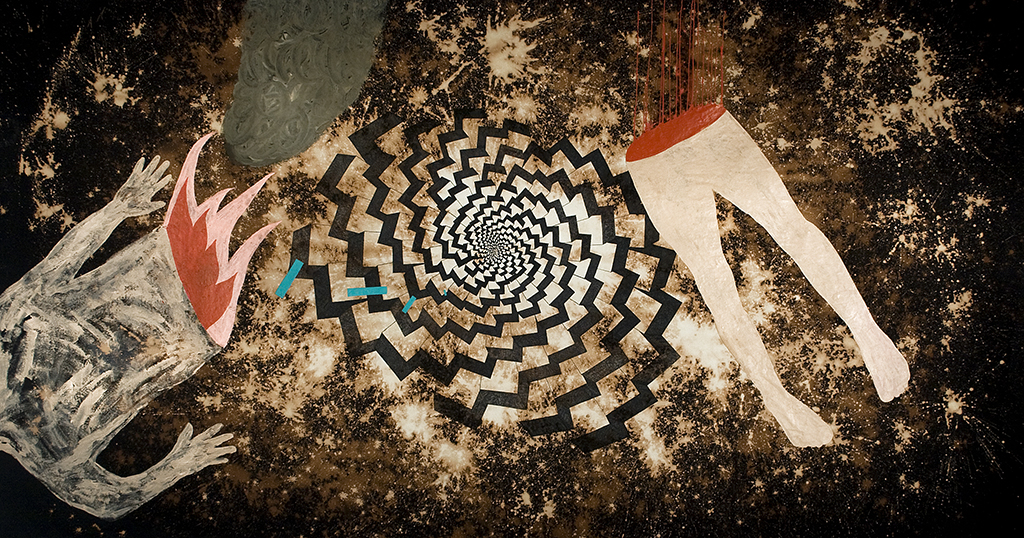
Gabinete de Hygiene, 4th-5th January 2013 in Espacio V, Valencia, Spain.
+ information: www.gabinetedehygiene.wordpress.com
Contemporary Istanbul 2012
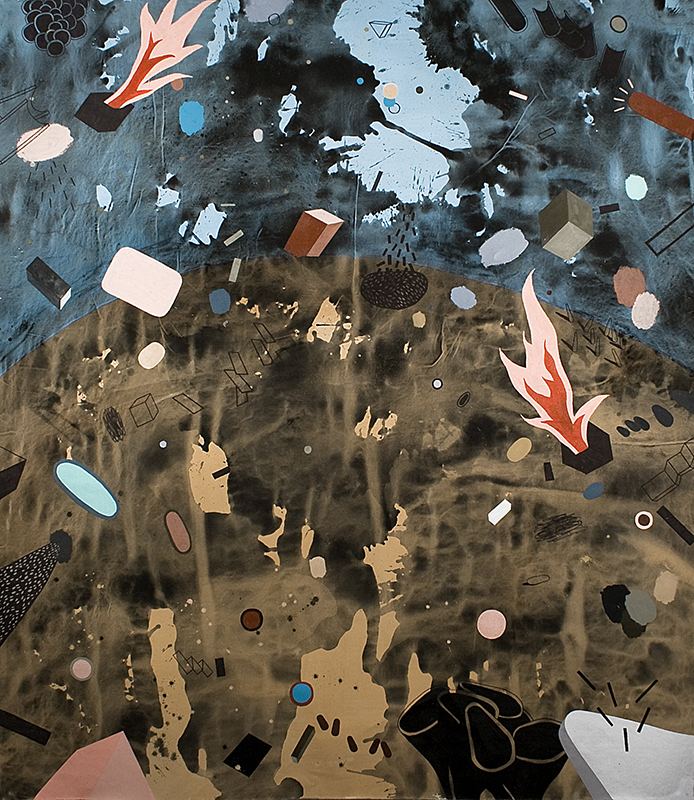
Volkan Diyaroglu will participate in Contemporary Istanbul 2012 that will take place between 22-25th of November 2012 at the Istanbul Convention and Exhibition Center (ICEC).
Works of Volkan Diyaroglu will be exhibited together with Peter Halley,Halil Akdeniz, Ozdemir Altan, Bubi, Yucel Donmez, Shems Friedlander etc. at Galeri Baraz stand.
MIMAA_Muestra Internacional de Música y Audiovisuales Avanzados
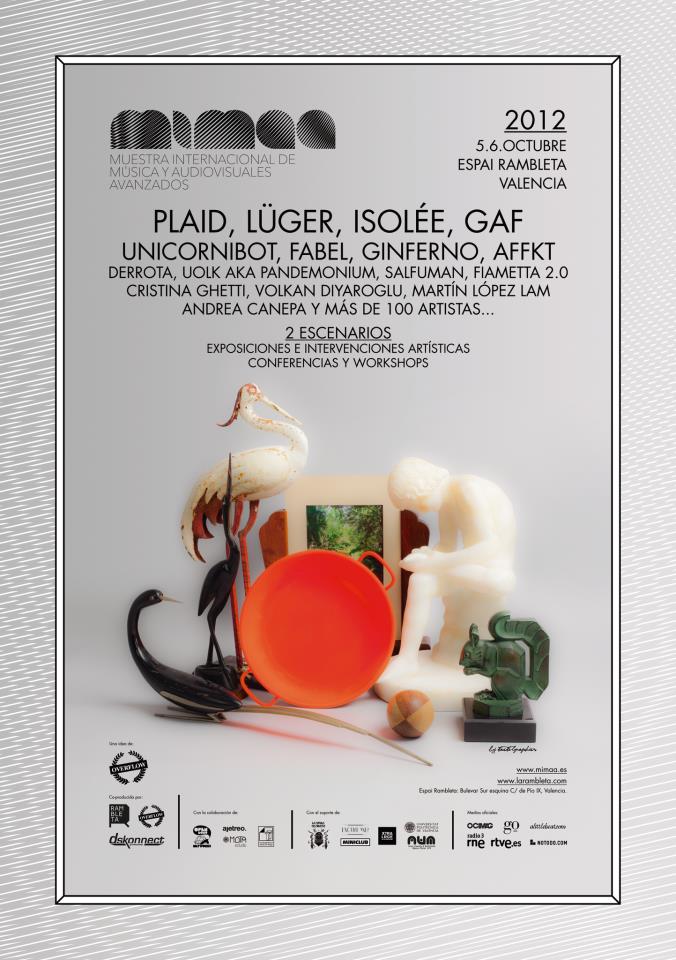
Volkan Diyaroglu will take part in MIMAA_Muestra Internacional de Música y Audiovisuales Avanzados, 5-6th October 2012, Espai Rambleta, Valencia, Spain.
+ information:
KreuzKassel ZWEI_ apocalyptic kebab by volkan diyaroglu
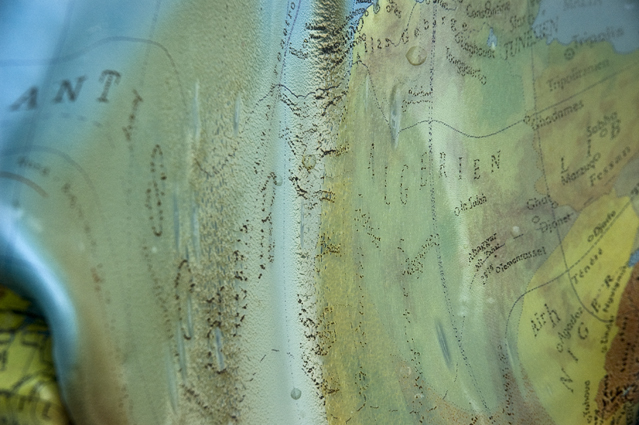
KreuzKassel ZWEI
Groupshow / Gruppenausstellung
Friday 24th August / Freitag 24.8.12
Kathrin Herzner, Tetyana Zolotopupova, Erkin Gören, Volkan Diyaroğlu, Ivana Sidzimovska, Ivar Veermae, Mari Poller, Gallery Fist, Alessandro Vitali, Andreas Helfer, Sergio Racanati, Tine Günther, Udo Lindemann, Leo Sexer, Michael Gärtner, Claudia Kapp
Die Ausstellungsreihe KREUZKASSEL entwirft das vermeintlich völlig irrationale Fusionsgebiet Kreuzberg-Kassel, welches von Partygängern und Kulturschaffenden entdeckt wird, diein Kreuzberg keine bezahlbare Wohnung mehr finden.Trotz dem Zeitalter der freiwilligen und unfreiwilligenMigrationen sollen Länder,Städte, Bezirke noch kulturelleAnkerpunkte bilden.
Während aktuelle Ausstellungen wie zB. “Made in GermanyZwei” in Hannover der geografischen wie nationalenBestandsaufnahme zu dienen scheinen, versucht derKreuzberg Pavillon als ständig umherziehende GuerillaInstitution,innerhalb und außerhalb Berlins, neoliberalennationalen Einheitsbildern mit den Entwürfen visionärerRäume entgegenzuwirken.
Die Idee der Vereinheitlichung wird in den unterschiedlichenArbeiten der KünstlerInnen von Kreuzkassel ZWEI aufgehoben.
FB EVENT : https://www.facebook.com/events/175671205891253/
Frankfurter Strasse 60, 34121 Kassel
info@kreuzbergpavillon.de, www.kreuzbergpavillon.de
1st Istanbul Summer Exhibition
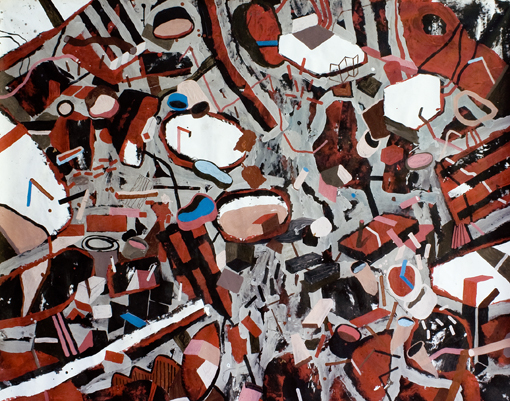
alone, alone 147X185 cm mixed technique on canvas 2008
1st Istanbul Summer Exhibition 8th June – 31st July 2011
Antrepo 5, Istanbul, Turkey
+information: http://www.istanbulyazsergisi.com/index.php
Sotheby’s Contemporary Turkish Art Auction
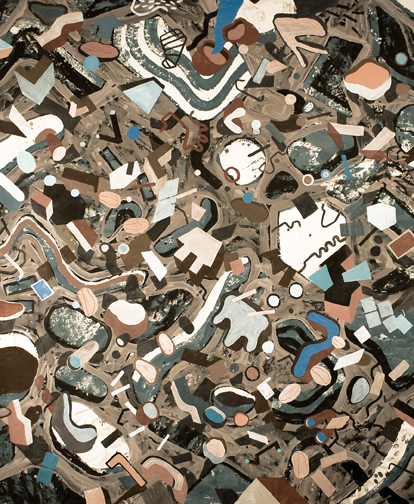
Volkan Diyaroglu "WORMHOLES" Ar/ Contemporary Gallery, Milano, Italy
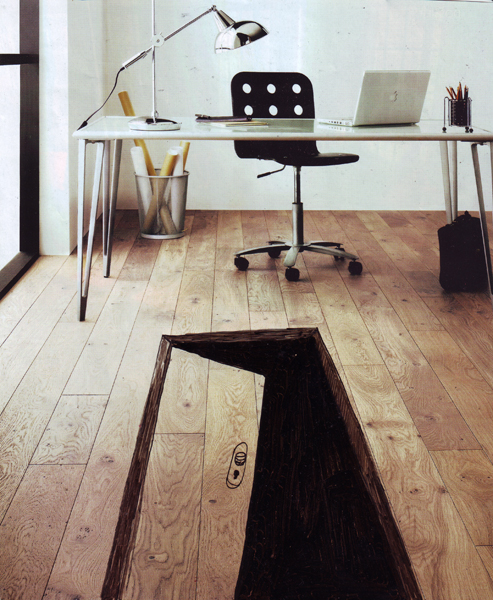
01/02/2010 – 30/03/2010
AR / Contemporary Art is pleased to announce an exhibition of Volkan Diyaroglu Milano via Marco Polo 11 tel. +39 02 4549 8902 Private View by appointment from monday through friday. New York 210 East 5 th Street. NY 10003 tel +1 212 671 1027 Private View by appointment.
If he saw a child near a mirror, he might wag his finger at a child warningly, and say with great solemnity, “Don’t get too near that leak. You wouldn’t want to wind up in the other universe, would you?”Read more
"CAOS VS ORDINE" _ AR / CONTEMPORARY GALLERY, MILAN

"in search of lost reality: nevgeneration" / Galeri Nev / Ankara
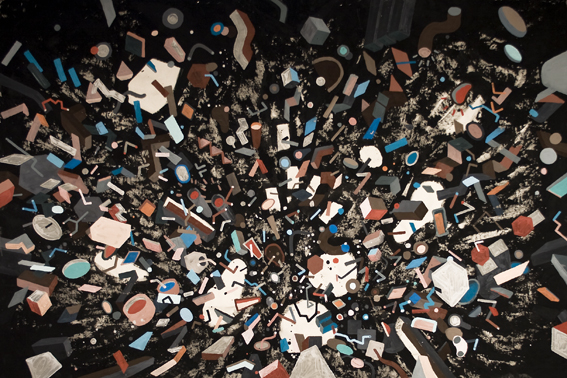
| Group Exhibition: in search of lost reality: nevgeneration |
| 15.05.2009 – 15.08.2009 Galeri Nev, Ankara, Turkey more information: http://www.galerinev.com/eng_exhibition.asp |
MAUS HABITOS_PORTO_16 APRIL-10 MAY 2009
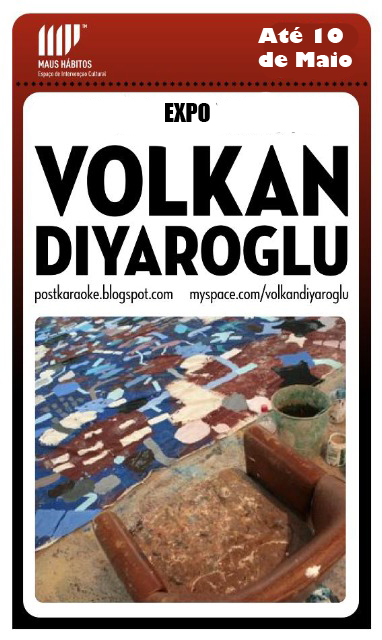
Volkan Diyaroglu will exhibit the works that he realized during the Maus Habitos Residence in April 2009.
Volkan Diyaroglu is in AL BASTAKIYA ART FAIR in Dubai with SAATCHI ONLINE
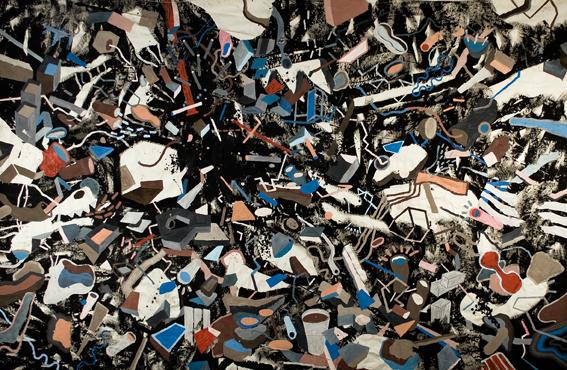
Volkan Diyaroglu will participate to Al Bastakiya Art Fair, in Dubai with Saatchi Online.
Now in its third year, Al BASTAKIYA ART FAIR (BAF) will take place in the houses of Bastakiya, the historic area of Dubai, 15 – 22 March 2009 and from 9am to 8pm daily.
The exhibition of the Saatchi Online in the fair is curated by, Saatchi Online’s critic and curator Ana Finel Honigman and Saatchi Online’s editor and curator Rebecca Wilson.
Beautiful Freak 5-27 March 2009, Forja Arte Contemporaneo
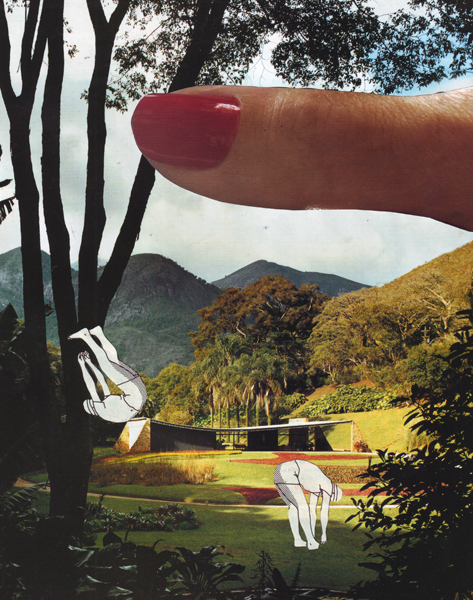
The artists:
Jorge Carla, David La Torre, Sergio Luna, Violeta Esparza, Volkan Diyaroglu, Ima Picó, Abraham Martínez, Daniel Reyes, Linda Randazzo, Leonardo Gutiérrez, Filippos Tsitsopoulos, Carlos Cid, Sergio Zavattieri, Cristian Peralta, Jorge López, Juan Jose Martin Andres, Rafael Molina, Federico Lupo, Nacho Ruiz, Oliver Johnson, Greta Alfaro.
+ information:
http://www.forjaarte.es/portal/
"MI VERTIGO" PAINTINGS AND TONI CALDERON TEXT
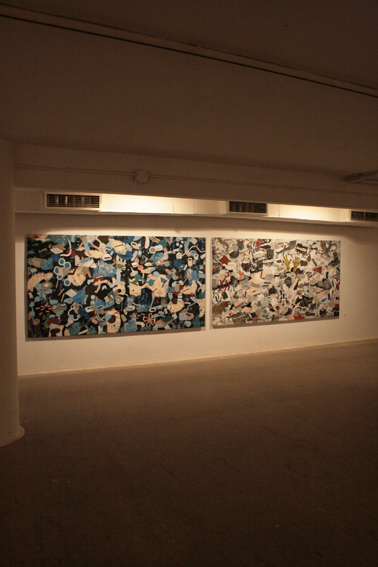
“el lienzo es un campo de juego en el que reproducir, rediseñar, analizar o expresar un objeto real o imaginario”
Harold Rosemberg
La obra del joven artista turco afincado en París Volkan Diyaroglu es mucho más que pintura. Para Volkan el proceso, las dimensiones y el espacio forman parte de su trabajo. Si su trabajo se analiza desde un punto estrictamente pictórico se evidencian claras similitudes con artistas universales del arte contemporáneo, en concreto, con los creadores de la “action painting” de los años cincuenta y también con la pintura renovada de principios de los ochenta o lo que es lo mismo, con el expresionismo abstracto de Jackson Pollock o la nueva pintura cuyo máximo exponente es Jean Michel Basquiat. Estas influencias, a priori, pueden definir a Volkan como un artista ecléctico en el sentido literal de la palabra, lo que no presume entenderlo en sentido peyorativo, pues el arte progresa y se anticipa cuando es capaz de conjugar pasado y presente a la hora de recorrer nuevos caminos. Read more
"DELIK" PAINTINGS AND JOSE MIR TEXT
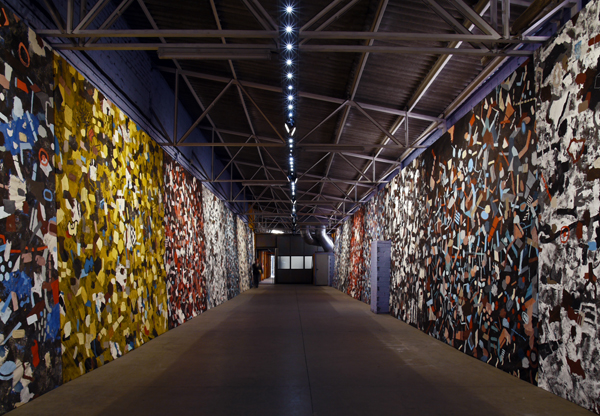
Nevertheless, a false sense of deja-vu shouldn’t influence the perception of the artist’s canvases in the least. One can appreciate how he immersed himself in his influences, both formal and those of process, to create experimental and free paintings whose borders continuously move in intuitive fountain of unlimited creativity. The elements are hybrids rather than pure, confused rather than clear, perversely indeterminate, elements that show the artist as a clear and individual personality.Read more

